Research Article Clinical Reasoning 846487
VerifiedAdded on 2022/08/15
|20
|10204
|8
AI Summary
Contribute Materials
Your contribution can guide someone’s learning journey. Share your
documents today.
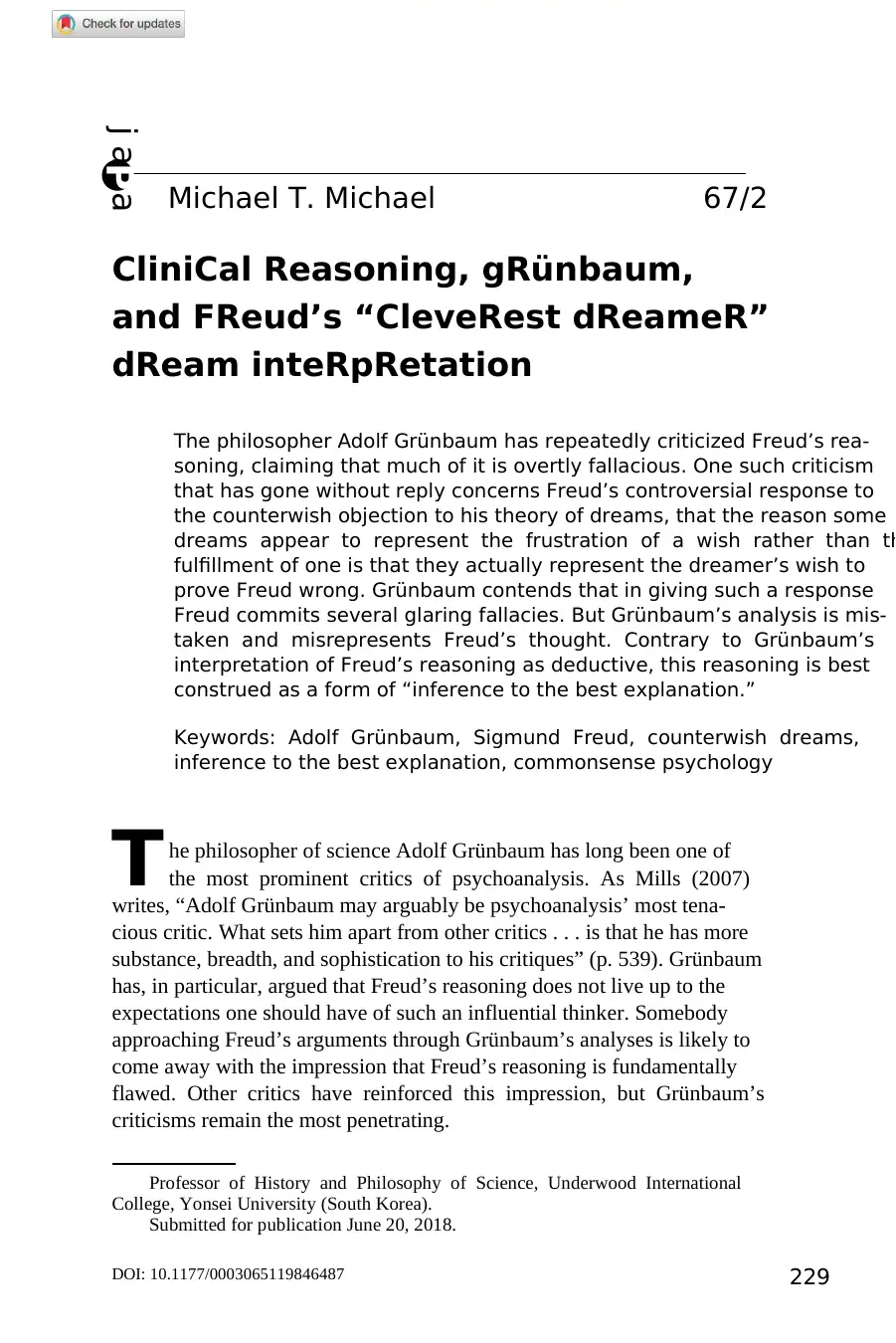
j aPa
229DOI: 10.1177/0003065119846487
67/2Michael T. Michael
CliniCal Reasoning, gRünbaum,
and FReud’s “CleveRest dReameR”
dReam inteRpRetation
The philosopher Adolf Grünbaum has repeatedly criticized Freud’s rea-
soning, claiming that much of it is overtly fallacious. One such criticism
that has gone without reply concerns Freud’s controversial response to
the counterwish objection to his theory of dreams, that the reason some
dreams appear to represent the frustration of a wish rather than th
fulfillment of one is that they actually represent the dreamer’s wish to
prove Freud wrong. Grünbaum contends that in giving such a response
Freud commits several glaring fallacies. But Grünbaum’s analysis is mis-
taken and misrepresents Freud’s thought. Contrary to Grünbaum’s
interpretation of Freud’s reasoning as deductive, this reasoning is best
construed as a form of “inference to the best explanation.”
Keywords: Adolf Grünbaum, Sigmund Freud, counterwish dreams,
inference to the best explanation, commonsense psychology
The philosopher of science Adolf Grünbaum has long been one of
the most prominent critics of psychoanalysis. As Mills (2007)
writes, “Adolf Grünbaum may arguably be psychoanalysis’ most tena-
cious critic. What sets him apart from other critics . . . is that he has more
substance, breadth, and sophistication to his critiques” (p. 539). Grünbaum
has, in particular, argued that Freud’s reasoning does not live up to the
expectations one should have of such an influential thinker. Somebody
approaching Freud’s arguments through Grünbaum’s analyses is likely to
come away with the impression that Freud’s reasoning is fundamentally
flawed. Other critics have reinforced this impression, but Grünbaum’s
criticisms remain the most penetrating.
Professor of History and Philosophy of Science, Underwood International
College, Yonsei University (South Korea).
Submitted for publication June 20, 2018.
846487 APAXXX10.1177/0003065119846487 michael t. michaelCLINICAL REASONING, GRÜNBAUM, AND FREUD
research-article 2019
229DOI: 10.1177/0003065119846487
67/2Michael T. Michael
CliniCal Reasoning, gRünbaum,
and FReud’s “CleveRest dReameR”
dReam inteRpRetation
The philosopher Adolf Grünbaum has repeatedly criticized Freud’s rea-
soning, claiming that much of it is overtly fallacious. One such criticism
that has gone without reply concerns Freud’s controversial response to
the counterwish objection to his theory of dreams, that the reason some
dreams appear to represent the frustration of a wish rather than th
fulfillment of one is that they actually represent the dreamer’s wish to
prove Freud wrong. Grünbaum contends that in giving such a response
Freud commits several glaring fallacies. But Grünbaum’s analysis is mis-
taken and misrepresents Freud’s thought. Contrary to Grünbaum’s
interpretation of Freud’s reasoning as deductive, this reasoning is best
construed as a form of “inference to the best explanation.”
Keywords: Adolf Grünbaum, Sigmund Freud, counterwish dreams,
inference to the best explanation, commonsense psychology
The philosopher of science Adolf Grünbaum has long been one of
the most prominent critics of psychoanalysis. As Mills (2007)
writes, “Adolf Grünbaum may arguably be psychoanalysis’ most tena-
cious critic. What sets him apart from other critics . . . is that he has more
substance, breadth, and sophistication to his critiques” (p. 539). Grünbaum
has, in particular, argued that Freud’s reasoning does not live up to the
expectations one should have of such an influential thinker. Somebody
approaching Freud’s arguments through Grünbaum’s analyses is likely to
come away with the impression that Freud’s reasoning is fundamentally
flawed. Other critics have reinforced this impression, but Grünbaum’s
criticisms remain the most penetrating.
Professor of History and Philosophy of Science, Underwood International
College, Yonsei University (South Korea).
Submitted for publication June 20, 2018.
846487 APAXXX10.1177/0003065119846487 michael t. michaelCLINICAL REASONING, GRÜNBAUM, AND FREUD
research-article 2019
Secure Best Marks with AI Grader
Need help grading? Try our AI Grader for instant feedback on your assignments.
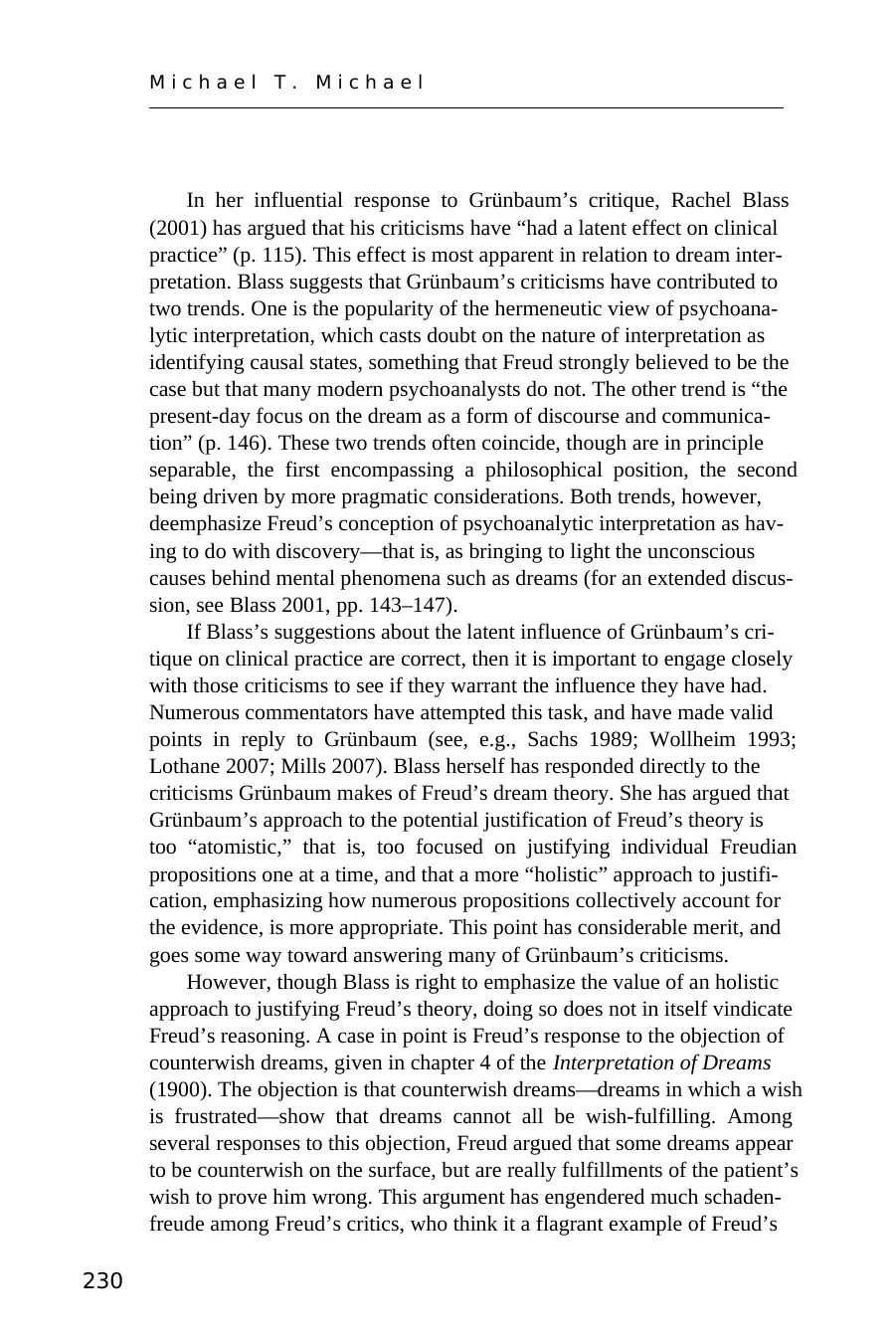
M i c h a e l T . M i c h a e l
230
In her influential response to Grünbaum’s critique, Rachel Blass
(2001) has argued that his criticisms have “had a latent effect on clinical
practice” (p. 115). This effect is most apparent in relation to dream inter-
pretation. Blass suggests that Grünbaum’s criticisms have contributed to
two trends. One is the popularity of the hermeneutic view of psychoana-
lytic interpretation, which casts doubt on the nature of interpretation as
identifying causal states, something that Freud strongly believed to be the
case but that many modern psychoanalysts do not. The other trend is “the
present-day focus on the dream as a form of discourse and communica-
tion” (p. 146). These two trends often coincide, though are in principle
separable, the first encompassing a philosophical position, the second
being driven by more pragmatic considerations. Both trends, however,
deemphasize Freud’s conception of psychoanalytic interpretation as hav-
ing to do with discovery—that is, as bringing to light the unconscious
causes behind mental phenomena such as dreams (for an extended discus-
sion, see Blass 2001, pp. 143–147).
If Blass’s suggestions about the latent influence of Grünbaum’s cri-
tique on clinical practice are correct, then it is important to engage closely
with those criticisms to see if they warrant the influence they have had.
Numerous commentators have attempted this task, and have made valid
points in reply to Grünbaum (see, e.g., Sachs 1989; Wollheim 1993;
Lothane 2007; Mills 2007). Blass herself has responded directly to the
criticisms Grünbaum makes of Freud’s dream theory. She has argued that
Grünbaum’s approach to the potential justification of Freud’s theory is
too “atomistic,” that is, too focused on justifying individual Freudian
propositions one at a time, and that a more “holistic” approach to justifi-
cation, emphasizing how numerous propositions collectively account for
the evidence, is more appropriate. This point has considerable merit, and
goes some way toward answering many of Grünbaum’s criticisms.
However, though Blass is right to emphasize the value of an holistic
approach to justifying Freud’s theory, doing so does not in itself vindicate
Freud’s reasoning. A case in point is Freud’s response to the objection of
counterwish dreams, given in chapter 4 of the Interpretation of Dreams
(1900). The objection is that counterwish dreams—dreams in which a wish
is frustrated—show that dreams cannot all be wish-fulfilling. Among
several responses to this objection, Freud argued that some dreams appear
to be counterwish on the surface, but are really fulfillments of the patient’s
wish to prove him wrong. This argument has engendered much schaden-
freude among Freud’s critics, who think it a flagrant example of Freud’s
230
In her influential response to Grünbaum’s critique, Rachel Blass
(2001) has argued that his criticisms have “had a latent effect on clinical
practice” (p. 115). This effect is most apparent in relation to dream inter-
pretation. Blass suggests that Grünbaum’s criticisms have contributed to
two trends. One is the popularity of the hermeneutic view of psychoana-
lytic interpretation, which casts doubt on the nature of interpretation as
identifying causal states, something that Freud strongly believed to be the
case but that many modern psychoanalysts do not. The other trend is “the
present-day focus on the dream as a form of discourse and communica-
tion” (p. 146). These two trends often coincide, though are in principle
separable, the first encompassing a philosophical position, the second
being driven by more pragmatic considerations. Both trends, however,
deemphasize Freud’s conception of psychoanalytic interpretation as hav-
ing to do with discovery—that is, as bringing to light the unconscious
causes behind mental phenomena such as dreams (for an extended discus-
sion, see Blass 2001, pp. 143–147).
If Blass’s suggestions about the latent influence of Grünbaum’s cri-
tique on clinical practice are correct, then it is important to engage closely
with those criticisms to see if they warrant the influence they have had.
Numerous commentators have attempted this task, and have made valid
points in reply to Grünbaum (see, e.g., Sachs 1989; Wollheim 1993;
Lothane 2007; Mills 2007). Blass herself has responded directly to the
criticisms Grünbaum makes of Freud’s dream theory. She has argued that
Grünbaum’s approach to the potential justification of Freud’s theory is
too “atomistic,” that is, too focused on justifying individual Freudian
propositions one at a time, and that a more “holistic” approach to justifi-
cation, emphasizing how numerous propositions collectively account for
the evidence, is more appropriate. This point has considerable merit, and
goes some way toward answering many of Grünbaum’s criticisms.
However, though Blass is right to emphasize the value of an holistic
approach to justifying Freud’s theory, doing so does not in itself vindicate
Freud’s reasoning. A case in point is Freud’s response to the objection of
counterwish dreams, given in chapter 4 of the Interpretation of Dreams
(1900). The objection is that counterwish dreams—dreams in which a wish
is frustrated—show that dreams cannot all be wish-fulfilling. Among
several responses to this objection, Freud argued that some dreams appear
to be counterwish on the surface, but are really fulfillments of the patient’s
wish to prove him wrong. This argument has engendered much schaden-
freude among Freud’s critics, who think it a flagrant example of Freud’s
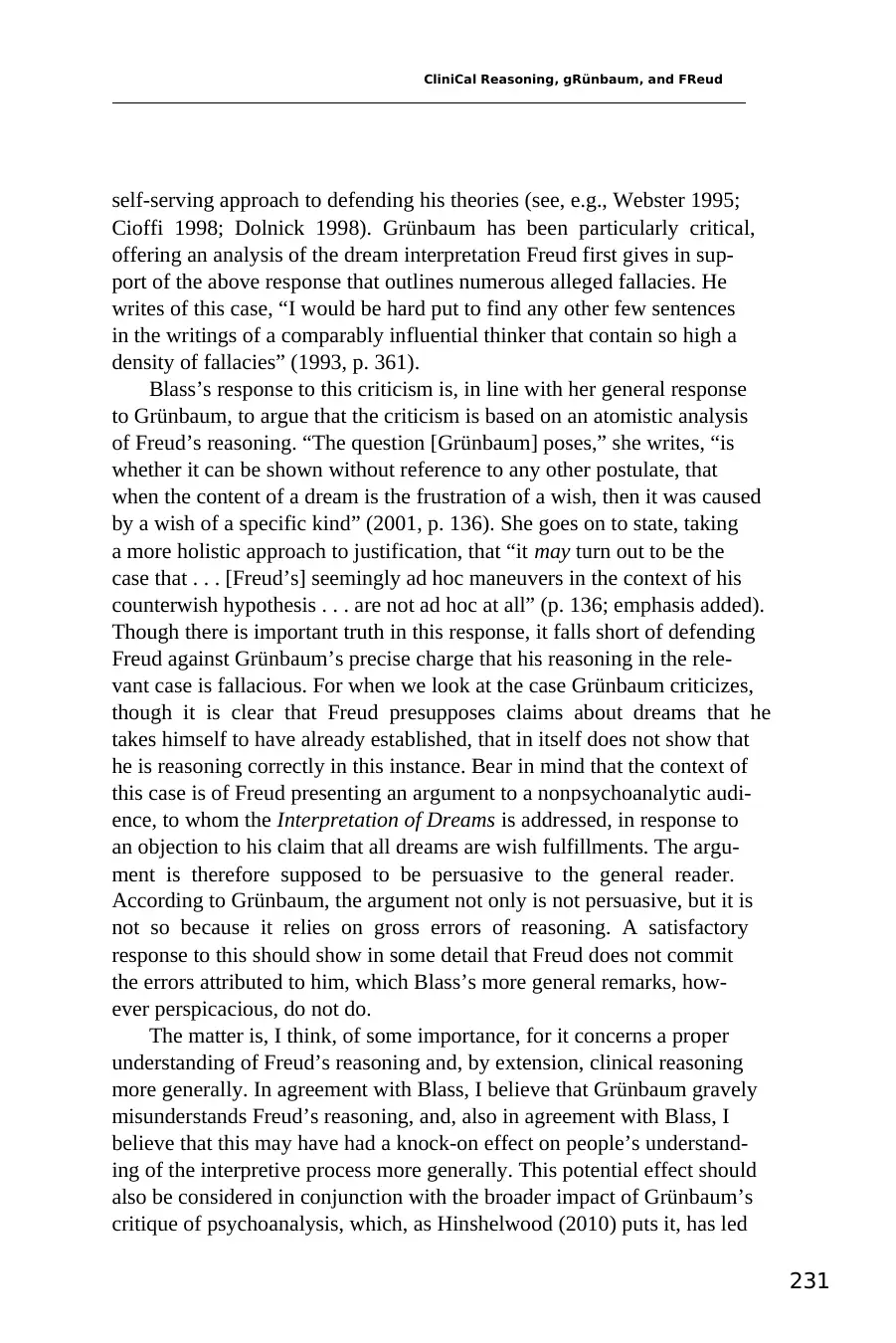
CliniCal Reasoning, gRünbaum, and FReud
231
self-serving approach to defending his theories (see, e.g., Webster 1995;
Cioffi 1998; Dolnick 1998). Grünbaum has been particularly critical,
offering an analysis of the dream interpretation Freud first gives in sup-
port of the above response that outlines numerous alleged fallacies. He
writes of this case, “I would be hard put to find any other few sentences
in the writings of a comparably influential thinker that contain so high a
density of fallacies” (1993, p. 361).
Blass’s response to this criticism is, in line with her general response
to Grünbaum, to argue that the criticism is based on an atomistic analysis
of Freud’s reasoning. “The question [Grünbaum] poses,” she writes, “is
whether it can be shown without reference to any other postulate, that
when the content of a dream is the frustration of a wish, then it was caused
by a wish of a specific kind” (2001, p. 136). She goes on to state, taking
a more holistic approach to justification, that “it may turn out to be the
case that . . . [Freud’s] seemingly ad hoc maneuvers in the context of his
counterwish hypothesis . . . are not ad hoc at all” (p. 136; emphasis added).
Though there is important truth in this response, it falls short of defending
Freud against Grünbaum’s precise charge that his reasoning in the rele-
vant case is fallacious. For when we look at the case Grünbaum criticizes,
though it is clear that Freud presupposes claims about dreams that he
takes himself to have already established, that in itself does not show that
he is reasoning correctly in this instance. Bear in mind that the context of
this case is of Freud presenting an argument to a nonpsychoanalytic audi-
ence, to whom the Interpretation of Dreams is addressed, in response to
an objection to his claim that all dreams are wish fulfillments. The argu-
ment is therefore supposed to be persuasive to the general reader.
According to Grünbaum, the argument not only is not persuasive, but it is
not so because it relies on gross errors of reasoning. A satisfactory
response to this should show in some detail that Freud does not commit
the errors attributed to him, which Blass’s more general remarks, how-
ever perspicacious, do not do.
The matter is, I think, of some importance, for it concerns a proper
understanding of Freud’s reasoning and, by extension, clinical reasoning
more generally. In agreement with Blass, I believe that Grünbaum gravely
misunderstands Freud’s reasoning, and, also in agreement with Blass, I
believe that this may have had a knock-on effect on people’s understand-
ing of the interpretive process more generally. This potential effect should
also be considered in conjunction with the broader impact of Grünbaum’s
critique of psychoanalysis, which, as Hinshelwood (2010) puts it, has led
231
self-serving approach to defending his theories (see, e.g., Webster 1995;
Cioffi 1998; Dolnick 1998). Grünbaum has been particularly critical,
offering an analysis of the dream interpretation Freud first gives in sup-
port of the above response that outlines numerous alleged fallacies. He
writes of this case, “I would be hard put to find any other few sentences
in the writings of a comparably influential thinker that contain so high a
density of fallacies” (1993, p. 361).
Blass’s response to this criticism is, in line with her general response
to Grünbaum, to argue that the criticism is based on an atomistic analysis
of Freud’s reasoning. “The question [Grünbaum] poses,” she writes, “is
whether it can be shown without reference to any other postulate, that
when the content of a dream is the frustration of a wish, then it was caused
by a wish of a specific kind” (2001, p. 136). She goes on to state, taking
a more holistic approach to justification, that “it may turn out to be the
case that . . . [Freud’s] seemingly ad hoc maneuvers in the context of his
counterwish hypothesis . . . are not ad hoc at all” (p. 136; emphasis added).
Though there is important truth in this response, it falls short of defending
Freud against Grünbaum’s precise charge that his reasoning in the rele-
vant case is fallacious. For when we look at the case Grünbaum criticizes,
though it is clear that Freud presupposes claims about dreams that he
takes himself to have already established, that in itself does not show that
he is reasoning correctly in this instance. Bear in mind that the context of
this case is of Freud presenting an argument to a nonpsychoanalytic audi-
ence, to whom the Interpretation of Dreams is addressed, in response to
an objection to his claim that all dreams are wish fulfillments. The argu-
ment is therefore supposed to be persuasive to the general reader.
According to Grünbaum, the argument not only is not persuasive, but it is
not so because it relies on gross errors of reasoning. A satisfactory
response to this should show in some detail that Freud does not commit
the errors attributed to him, which Blass’s more general remarks, how-
ever perspicacious, do not do.
The matter is, I think, of some importance, for it concerns a proper
understanding of Freud’s reasoning and, by extension, clinical reasoning
more generally. In agreement with Blass, I believe that Grünbaum gravely
misunderstands Freud’s reasoning, and, also in agreement with Blass, I
believe that this may have had a knock-on effect on people’s understand-
ing of the interpretive process more generally. This potential effect should
also be considered in conjunction with the broader impact of Grünbaum’s
critique of psychoanalysis, which, as Hinshelwood (2010) puts it, has led
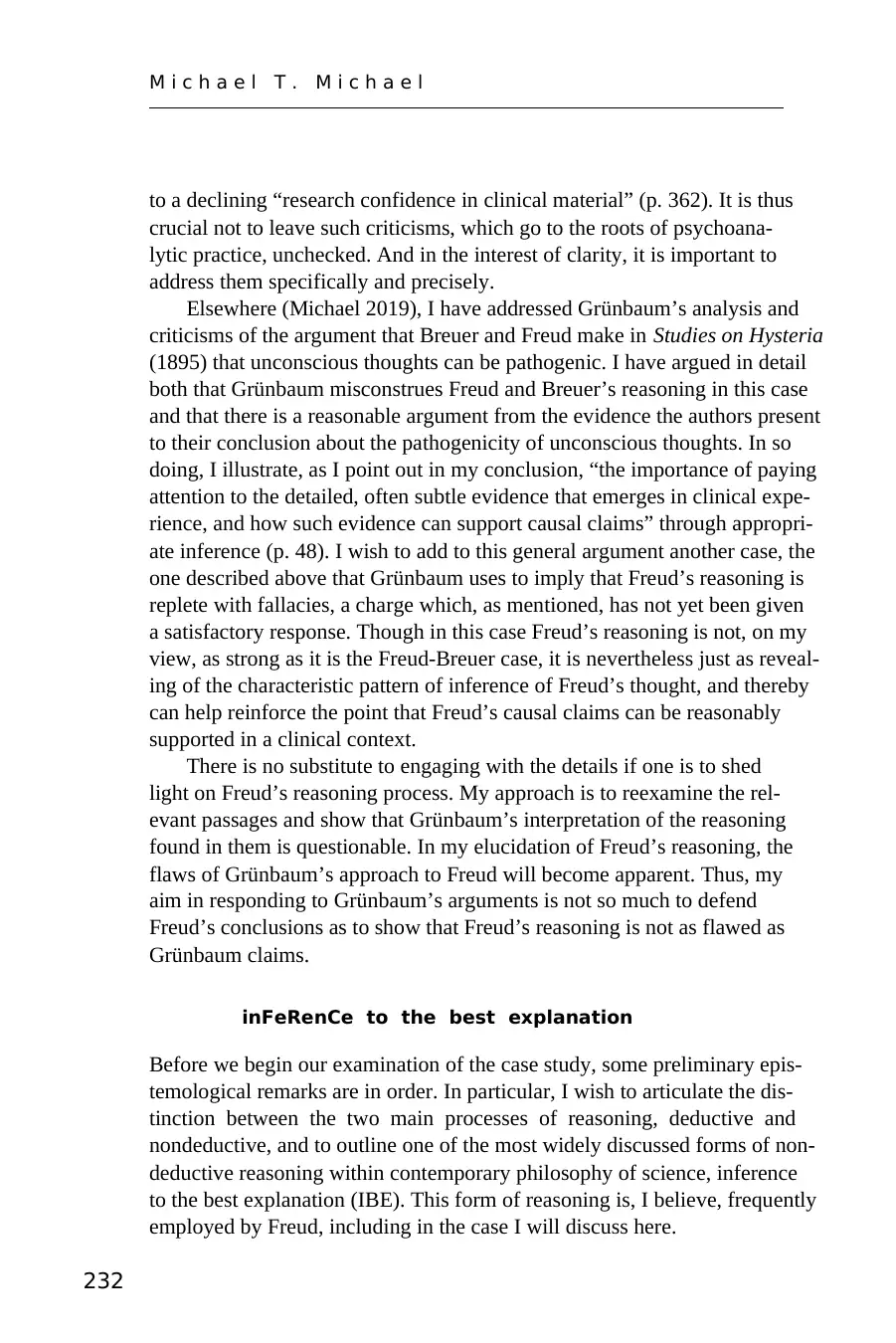
M i c h a e l T . M i c h a e l
232
to a declining “research confidence in clinical material” (p. 362). It is thus
crucial not to leave such criticisms, which go to the roots of psychoana-
lytic practice, unchecked. And in the interest of clarity, it is important to
address them specifically and precisely.
Elsewhere (Michael 2019), I have addressed Grünbaum’s analysis and
criticisms of the argument that Breuer and Freud make in Studies on Hysteria
(1895) that unconscious thoughts can be pathogenic. I have argued in detail
both that Grünbaum misconstrues Freud and Breuer’s reasoning in this case
and that there is a reasonable argument from the evidence the authors present
to their conclusion about the pathogenicity of unconscious thoughts. In so
doing, I illustrate, as I point out in my conclusion, “the importance of paying
attention to the detailed, often subtle evidence that emerges in clinical expe-
rience, and how such evidence can support causal claims” through appropri-
ate inference (p. 48). I wish to add to this general argument another case, the
one described above that Grünbaum uses to imply that Freud’s reasoning is
replete with fallacies, a charge which, as mentioned, has not yet been given
a satisfactory response. Though in this case Freud’s reasoning is not, on my
view, as strong as it is the Freud-Breuer case, it is nevertheless just as reveal-
ing of the characteristic pattern of inference of Freud’s thought, and thereby
can help reinforce the point that Freud’s causal claims can be reasonably
supported in a clinical context.
There is no substitute to engaging with the details if one is to shed
light on Freud’s reasoning process. My approach is to reexamine the rel-
evant passages and show that Grünbaum’s interpretation of the reasoning
found in them is questionable. In my elucidation of Freud’s reasoning, the
flaws of Grünbaum’s approach to Freud will become apparent. Thus, my
aim in responding to Grünbaum’s arguments is not so much to defend
Freud’s conclusions as to show that Freud’s reasoning is not as flawed as
Grünbaum claims.
inFeRenCe to the best explanation
Before we begin our examination of the case study, some preliminary epis-
temological remarks are in order. In particular, I wish to articulate the dis-
tinction between the two main processes of reasoning, deductive and
nondeductive, and to outline one of the most widely discussed forms of non-
deductive reasoning within contemporary philosophy of science, inference
to the best explanation (IBE). This form of reasoning is, I believe, frequently
employed by Freud, including in the case I will discuss here.
232
to a declining “research confidence in clinical material” (p. 362). It is thus
crucial not to leave such criticisms, which go to the roots of psychoana-
lytic practice, unchecked. And in the interest of clarity, it is important to
address them specifically and precisely.
Elsewhere (Michael 2019), I have addressed Grünbaum’s analysis and
criticisms of the argument that Breuer and Freud make in Studies on Hysteria
(1895) that unconscious thoughts can be pathogenic. I have argued in detail
both that Grünbaum misconstrues Freud and Breuer’s reasoning in this case
and that there is a reasonable argument from the evidence the authors present
to their conclusion about the pathogenicity of unconscious thoughts. In so
doing, I illustrate, as I point out in my conclusion, “the importance of paying
attention to the detailed, often subtle evidence that emerges in clinical expe-
rience, and how such evidence can support causal claims” through appropri-
ate inference (p. 48). I wish to add to this general argument another case, the
one described above that Grünbaum uses to imply that Freud’s reasoning is
replete with fallacies, a charge which, as mentioned, has not yet been given
a satisfactory response. Though in this case Freud’s reasoning is not, on my
view, as strong as it is the Freud-Breuer case, it is nevertheless just as reveal-
ing of the characteristic pattern of inference of Freud’s thought, and thereby
can help reinforce the point that Freud’s causal claims can be reasonably
supported in a clinical context.
There is no substitute to engaging with the details if one is to shed
light on Freud’s reasoning process. My approach is to reexamine the rel-
evant passages and show that Grünbaum’s interpretation of the reasoning
found in them is questionable. In my elucidation of Freud’s reasoning, the
flaws of Grünbaum’s approach to Freud will become apparent. Thus, my
aim in responding to Grünbaum’s arguments is not so much to defend
Freud’s conclusions as to show that Freud’s reasoning is not as flawed as
Grünbaum claims.
inFeRenCe to the best explanation
Before we begin our examination of the case study, some preliminary epis-
temological remarks are in order. In particular, I wish to articulate the dis-
tinction between the two main processes of reasoning, deductive and
nondeductive, and to outline one of the most widely discussed forms of non-
deductive reasoning within contemporary philosophy of science, inference
to the best explanation (IBE). This form of reasoning is, I believe, frequently
employed by Freud, including in the case I will discuss here.
Secure Best Marks with AI Grader
Need help grading? Try our AI Grader for instant feedback on your assignments.
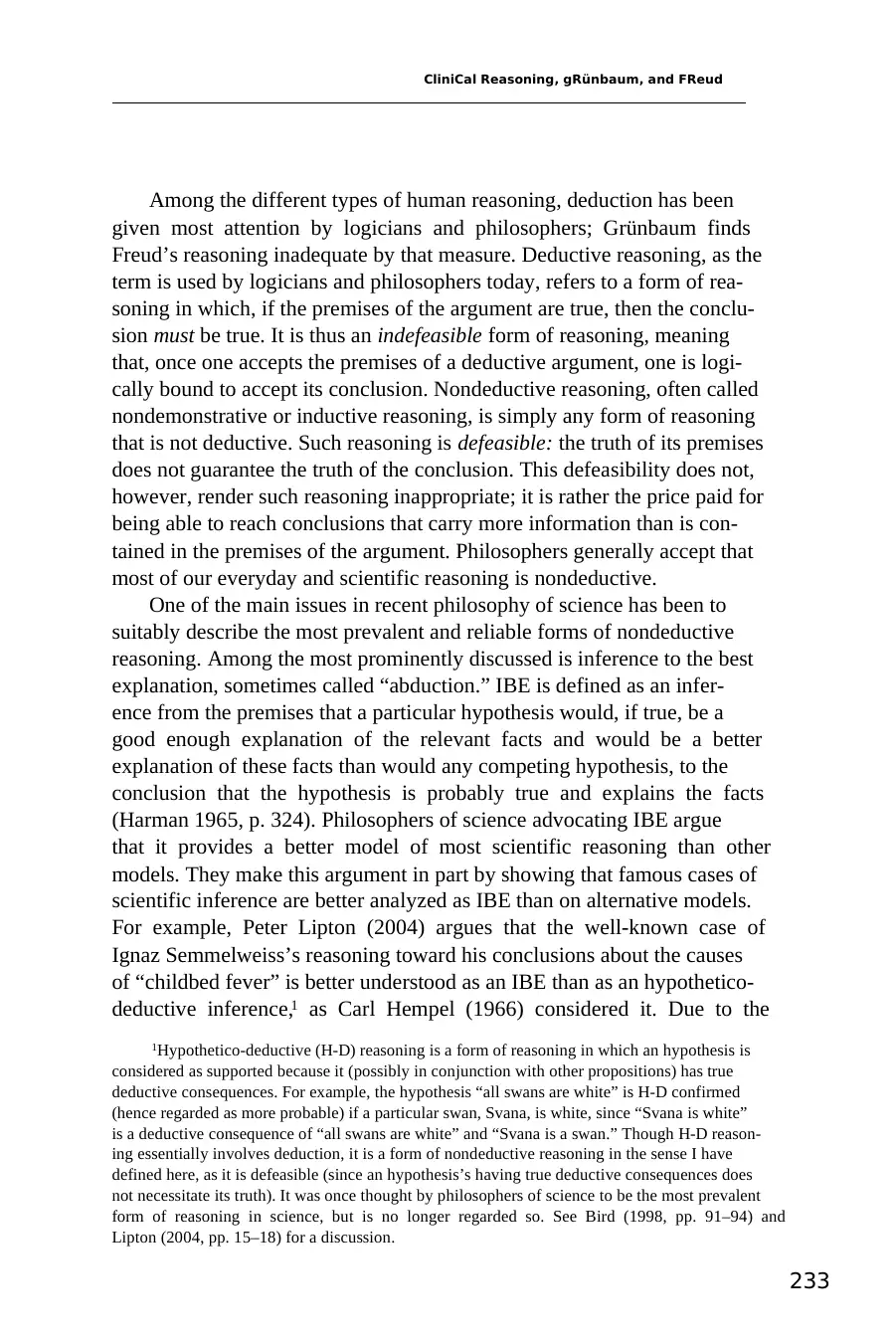
CliniCal Reasoning, gRünbaum, and FReud
233
Among the different types of human reasoning, deduction has been
given most attention by logicians and philosophers; Grünbaum finds
Freud’s reasoning inadequate by that measure. Deductive reasoning, as the
term is used by logicians and philosophers today, refers to a form of rea-
soning in which, if the premises of the argument are true, then the conclu-
sion must be true. It is thus an indefeasible form of reasoning, meaning
that, once one accepts the premises of a deductive argument, one is logi-
cally bound to accept its conclusion. Nondeductive reasoning, often called
nondemonstrative or inductive reasoning, is simply any form of reasoning
that is not deductive. Such reasoning is defeasible: the truth of its premises
does not guarantee the truth of the conclusion. This defeasibility does not,
however, render such reasoning inappropriate; it is rather the price paid for
being able to reach conclusions that carry more information than is con-
tained in the premises of the argument. Philosophers generally accept that
most of our everyday and scientific reasoning is nondeductive.
One of the main issues in recent philosophy of science has been to
suitably describe the most prevalent and reliable forms of nondeductive
reasoning. Among the most prominently discussed is inference to the best
explanation, sometimes called “abduction.” IBE is defined as an infer-
ence from the premises that a particular hypothesis would, if true, be a
good enough explanation of the relevant facts and would be a better
explanation of these facts than would any competing hypothesis, to the
conclusion that the hypothesis is probably true and explains the facts
(Harman 1965, p. 324). Philosophers of science advocating IBE argue
that it provides a better model of most scientific reasoning than other
models. They make this argument in part by showing that famous cases of
scientific inference are better analyzed as IBE than on alternative models.
For example, Peter Lipton (2004) argues that the well-known case of
Ignaz Semmelweiss’s reasoning toward his conclusions about the causes
of “childbed fever” is better understood as an IBE than as an hypothetico-
deductive inference,1 as Carl Hempel (1966) considered it. Due to the
1Hypothetico-deductive (H-D) reasoning is a form of reasoning in which an hypothesis is
considered as supported because it (possibly in conjunction with other propositions) has true
deductive consequences. For example, the hypothesis “all swans are white” is H-D confirmed
(hence regarded as more probable) if a particular swan, Svana, is white, since “Svana is white”
is a deductive consequence of “all swans are white” and “Svana is a swan.” Though H-D reason-
ing essentially involves deduction, it is a form of nondeductive reasoning in the sense I have
defined here, as it is defeasible (since an hypothesis’s having true deductive consequences does
not necessitate its truth). It was once thought by philosophers of science to be the most prevalent
form of reasoning in science, but is no longer regarded so. See Bird (1998, pp. 91–94) and
Lipton (2004, pp. 15–18) for a discussion.
233
Among the different types of human reasoning, deduction has been
given most attention by logicians and philosophers; Grünbaum finds
Freud’s reasoning inadequate by that measure. Deductive reasoning, as the
term is used by logicians and philosophers today, refers to a form of rea-
soning in which, if the premises of the argument are true, then the conclu-
sion must be true. It is thus an indefeasible form of reasoning, meaning
that, once one accepts the premises of a deductive argument, one is logi-
cally bound to accept its conclusion. Nondeductive reasoning, often called
nondemonstrative or inductive reasoning, is simply any form of reasoning
that is not deductive. Such reasoning is defeasible: the truth of its premises
does not guarantee the truth of the conclusion. This defeasibility does not,
however, render such reasoning inappropriate; it is rather the price paid for
being able to reach conclusions that carry more information than is con-
tained in the premises of the argument. Philosophers generally accept that
most of our everyday and scientific reasoning is nondeductive.
One of the main issues in recent philosophy of science has been to
suitably describe the most prevalent and reliable forms of nondeductive
reasoning. Among the most prominently discussed is inference to the best
explanation, sometimes called “abduction.” IBE is defined as an infer-
ence from the premises that a particular hypothesis would, if true, be a
good enough explanation of the relevant facts and would be a better
explanation of these facts than would any competing hypothesis, to the
conclusion that the hypothesis is probably true and explains the facts
(Harman 1965, p. 324). Philosophers of science advocating IBE argue
that it provides a better model of most scientific reasoning than other
models. They make this argument in part by showing that famous cases of
scientific inference are better analyzed as IBE than on alternative models.
For example, Peter Lipton (2004) argues that the well-known case of
Ignaz Semmelweiss’s reasoning toward his conclusions about the causes
of “childbed fever” is better understood as an IBE than as an hypothetico-
deductive inference,1 as Carl Hempel (1966) considered it. Due to the
1Hypothetico-deductive (H-D) reasoning is a form of reasoning in which an hypothesis is
considered as supported because it (possibly in conjunction with other propositions) has true
deductive consequences. For example, the hypothesis “all swans are white” is H-D confirmed
(hence regarded as more probable) if a particular swan, Svana, is white, since “Svana is white”
is a deductive consequence of “all swans are white” and “Svana is a swan.” Though H-D reason-
ing essentially involves deduction, it is a form of nondeductive reasoning in the sense I have
defined here, as it is defeasible (since an hypothesis’s having true deductive consequences does
not necessitate its truth). It was once thought by philosophers of science to be the most prevalent
form of reasoning in science, but is no longer regarded so. See Bird (1998, pp. 91–94) and
Lipton (2004, pp. 15–18) for a discussion.
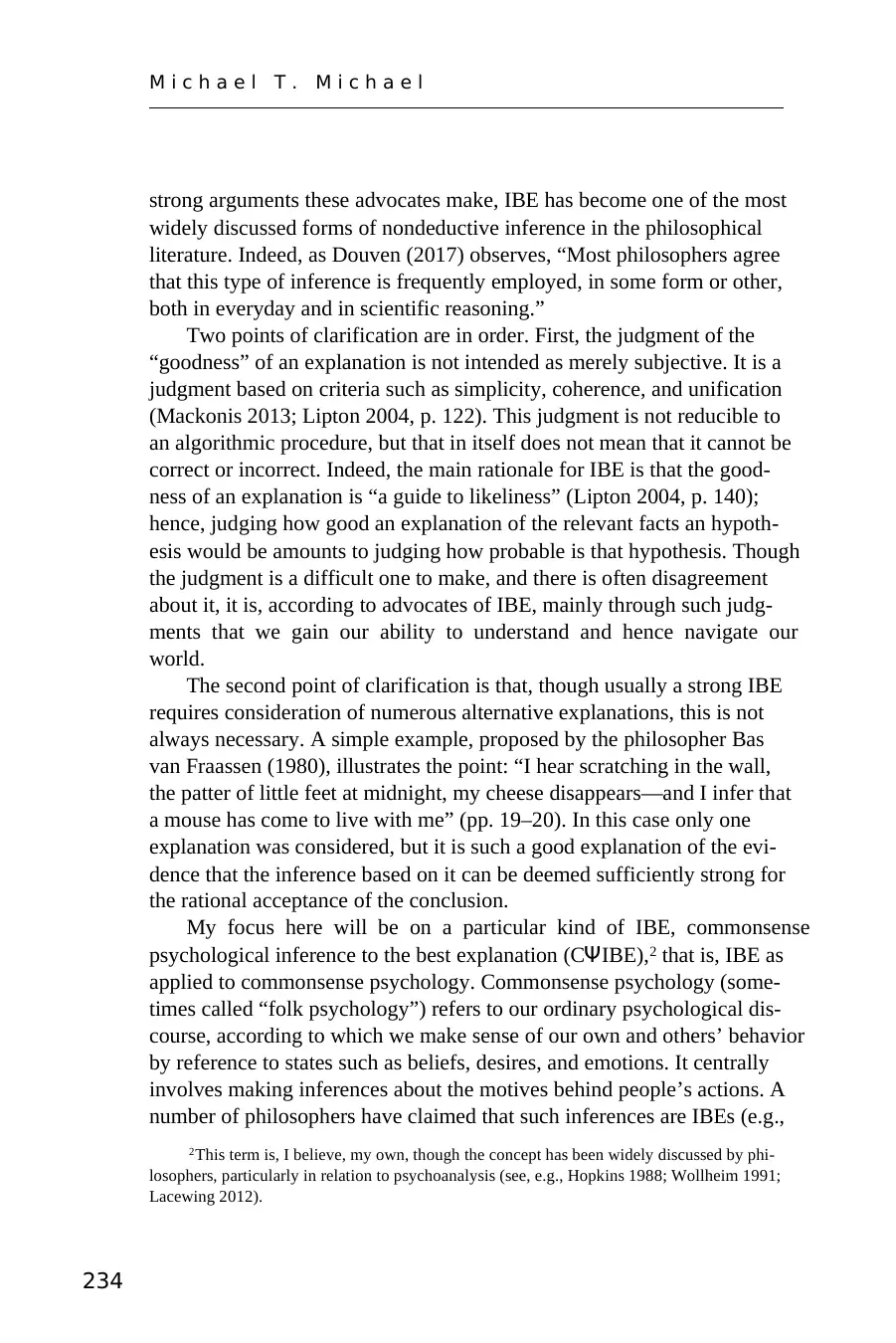
M i c h a e l T . M i c h a e l
234
strong arguments these advocates make, IBE has become one of the most
widely discussed forms of nondeductive inference in the philosophical
literature. Indeed, as Douven (2017) observes, “Most philosophers agree
that this type of inference is frequently employed, in some form or other,
both in everyday and in scientific reasoning.”
Two points of clarification are in order. First, the judgment of the
“goodness” of an explanation is not intended as merely subjective. It is a
judgment based on criteria such as simplicity, coherence, and unification
(Mackonis 2013; Lipton 2004, p. 122). This judgment is not reducible to
an algorithmic procedure, but that in itself does not mean that it cannot be
correct or incorrect. Indeed, the main rationale for IBE is that the good-
ness of an explanation is “a guide to likeliness” (Lipton 2004, p. 140);
hence, judging how good an explanation of the relevant facts an hypoth-
esis would be amounts to judging how probable is that hypothesis. Though
the judgment is a difficult one to make, and there is often disagreement
about it, it is, according to advocates of IBE, mainly through such judg-
ments that we gain our ability to understand and hence navigate our
world.
The second point of clarification is that, though usually a strong IBE
requires consideration of numerous alternative explanations, this is not
always necessary. A simple example, proposed by the philosopher Bas
van Fraassen (1980), illustrates the point: “I hear scratching in the wall,
the patter of little feet at midnight, my cheese disappears—and I infer that
a mouse has come to live with me” (pp. 19–20). In this case only one
explanation was considered, but it is such a good explanation of the evi-
dence that the inference based on it can be deemed sufficiently strong for
the rational acceptance of the conclusion.
My focus here will be on a particular kind of IBE, commonsense
psychological inference to the best explanation (CΨIBE),2 that is, IBE as
applied to commonsense psychology. Commonsense psychology (some-
times called “folk psychology”) refers to our ordinary psychological dis-
course, according to which we make sense of our own and others’ behavior
by reference to states such as beliefs, desires, and emotions. It centrally
involves making inferences about the motives behind people’s actions. A
number of philosophers have claimed that such inferences are IBEs (e.g.,
2This term is, I believe, my own, though the concept has been widely discussed by phi-
losophers, particularly in relation to psychoanalysis (see, e.g., Hopkins 1988; Wollheim 1991;
Lacewing 2012).
234
strong arguments these advocates make, IBE has become one of the most
widely discussed forms of nondeductive inference in the philosophical
literature. Indeed, as Douven (2017) observes, “Most philosophers agree
that this type of inference is frequently employed, in some form or other,
both in everyday and in scientific reasoning.”
Two points of clarification are in order. First, the judgment of the
“goodness” of an explanation is not intended as merely subjective. It is a
judgment based on criteria such as simplicity, coherence, and unification
(Mackonis 2013; Lipton 2004, p. 122). This judgment is not reducible to
an algorithmic procedure, but that in itself does not mean that it cannot be
correct or incorrect. Indeed, the main rationale for IBE is that the good-
ness of an explanation is “a guide to likeliness” (Lipton 2004, p. 140);
hence, judging how good an explanation of the relevant facts an hypoth-
esis would be amounts to judging how probable is that hypothesis. Though
the judgment is a difficult one to make, and there is often disagreement
about it, it is, according to advocates of IBE, mainly through such judg-
ments that we gain our ability to understand and hence navigate our
world.
The second point of clarification is that, though usually a strong IBE
requires consideration of numerous alternative explanations, this is not
always necessary. A simple example, proposed by the philosopher Bas
van Fraassen (1980), illustrates the point: “I hear scratching in the wall,
the patter of little feet at midnight, my cheese disappears—and I infer that
a mouse has come to live with me” (pp. 19–20). In this case only one
explanation was considered, but it is such a good explanation of the evi-
dence that the inference based on it can be deemed sufficiently strong for
the rational acceptance of the conclusion.
My focus here will be on a particular kind of IBE, commonsense
psychological inference to the best explanation (CΨIBE),2 that is, IBE as
applied to commonsense psychology. Commonsense psychology (some-
times called “folk psychology”) refers to our ordinary psychological dis-
course, according to which we make sense of our own and others’ behavior
by reference to states such as beliefs, desires, and emotions. It centrally
involves making inferences about the motives behind people’s actions. A
number of philosophers have claimed that such inferences are IBEs (e.g.,
2This term is, I believe, my own, though the concept has been widely discussed by phi-
losophers, particularly in relation to psychoanalysis (see, e.g., Hopkins 1988; Wollheim 1991;
Lacewing 2012).
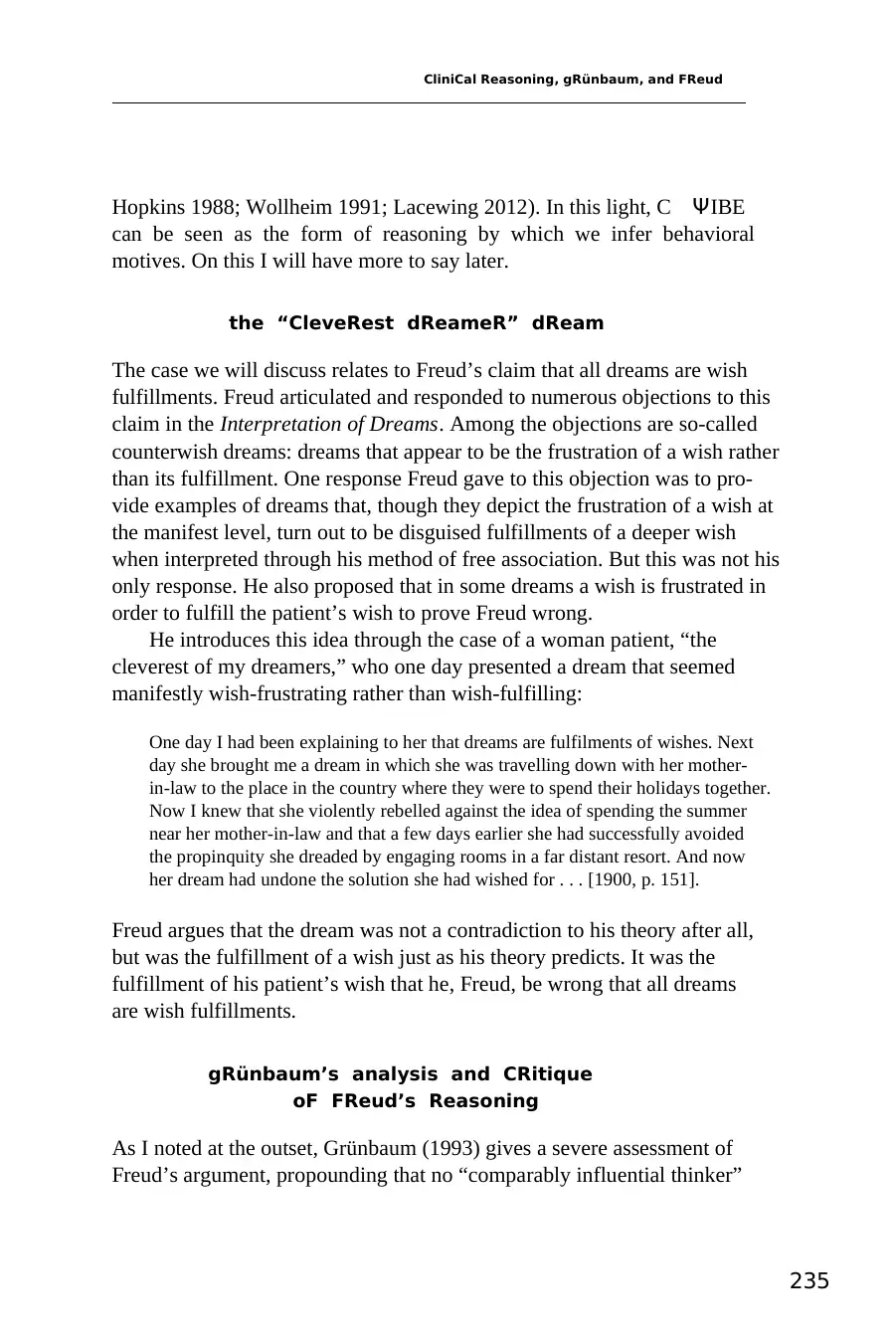
CliniCal Reasoning, gRünbaum, and FReud
235
Hopkins 1988; Wollheim 1991; Lacewing 2012). In this light, C ΨIBE
can be seen as the form of reasoning by which we infer behavioral
motives. On this I will have more to say later.
the “CleveRest dReameR” dReam
The case we will discuss relates to Freud’s claim that all dreams are wish
fulfillments. Freud articulated and responded to numerous objections to this
claim in the Interpretation of Dreams. Among the objections are so-called
counterwish dreams: dreams that appear to be the frustration of a wish rather
than its fulfillment. One response Freud gave to this objection was to pro-
vide examples of dreams that, though they depict the frustration of a wish at
the manifest level, turn out to be disguised fulfillments of a deeper wish
when interpreted through his method of free association. But this was not his
only response. He also proposed that in some dreams a wish is frustrated in
order to fulfill the patient’s wish to prove Freud wrong.
He introduces this idea through the case of a woman patient, “the
cleverest of my dreamers,” who one day presented a dream that seemed
manifestly wish-frustrating rather than wish-fulfilling:
One day I had been explaining to her that dreams are fulfilments of wishes. Next
day she brought me a dream in which she was travelling down with her mother-
in-law to the place in the country where they were to spend their holidays together.
Now I knew that she violently rebelled against the idea of spending the summer
near her mother-in-law and that a few days earlier she had successfully avoided
the propinquity she dreaded by engaging rooms in a far distant resort. And now
her dream had undone the solution she had wished for . . . [1900, p. 151].
Freud argues that the dream was not a contradiction to his theory after all,
but was the fulfillment of a wish just as his theory predicts. It was the
fulfillment of his patient’s wish that he, Freud, be wrong that all dreams
are wish fulfillments.
gRünbaum’s analysis and CRitique
oF FReud’s Reasoning
As I noted at the outset, Grünbaum (1993) gives a severe assessment of
Freud’s argument, propounding that no “comparably influential thinker”
235
Hopkins 1988; Wollheim 1991; Lacewing 2012). In this light, C ΨIBE
can be seen as the form of reasoning by which we infer behavioral
motives. On this I will have more to say later.
the “CleveRest dReameR” dReam
The case we will discuss relates to Freud’s claim that all dreams are wish
fulfillments. Freud articulated and responded to numerous objections to this
claim in the Interpretation of Dreams. Among the objections are so-called
counterwish dreams: dreams that appear to be the frustration of a wish rather
than its fulfillment. One response Freud gave to this objection was to pro-
vide examples of dreams that, though they depict the frustration of a wish at
the manifest level, turn out to be disguised fulfillments of a deeper wish
when interpreted through his method of free association. But this was not his
only response. He also proposed that in some dreams a wish is frustrated in
order to fulfill the patient’s wish to prove Freud wrong.
He introduces this idea through the case of a woman patient, “the
cleverest of my dreamers,” who one day presented a dream that seemed
manifestly wish-frustrating rather than wish-fulfilling:
One day I had been explaining to her that dreams are fulfilments of wishes. Next
day she brought me a dream in which she was travelling down with her mother-
in-law to the place in the country where they were to spend their holidays together.
Now I knew that she violently rebelled against the idea of spending the summer
near her mother-in-law and that a few days earlier she had successfully avoided
the propinquity she dreaded by engaging rooms in a far distant resort. And now
her dream had undone the solution she had wished for . . . [1900, p. 151].
Freud argues that the dream was not a contradiction to his theory after all,
but was the fulfillment of a wish just as his theory predicts. It was the
fulfillment of his patient’s wish that he, Freud, be wrong that all dreams
are wish fulfillments.
gRünbaum’s analysis and CRitique
oF FReud’s Reasoning
As I noted at the outset, Grünbaum (1993) gives a severe assessment of
Freud’s argument, propounding that no “comparably influential thinker”
Paraphrase This Document
Need a fresh take? Get an instant paraphrase of this document with our AI Paraphraser
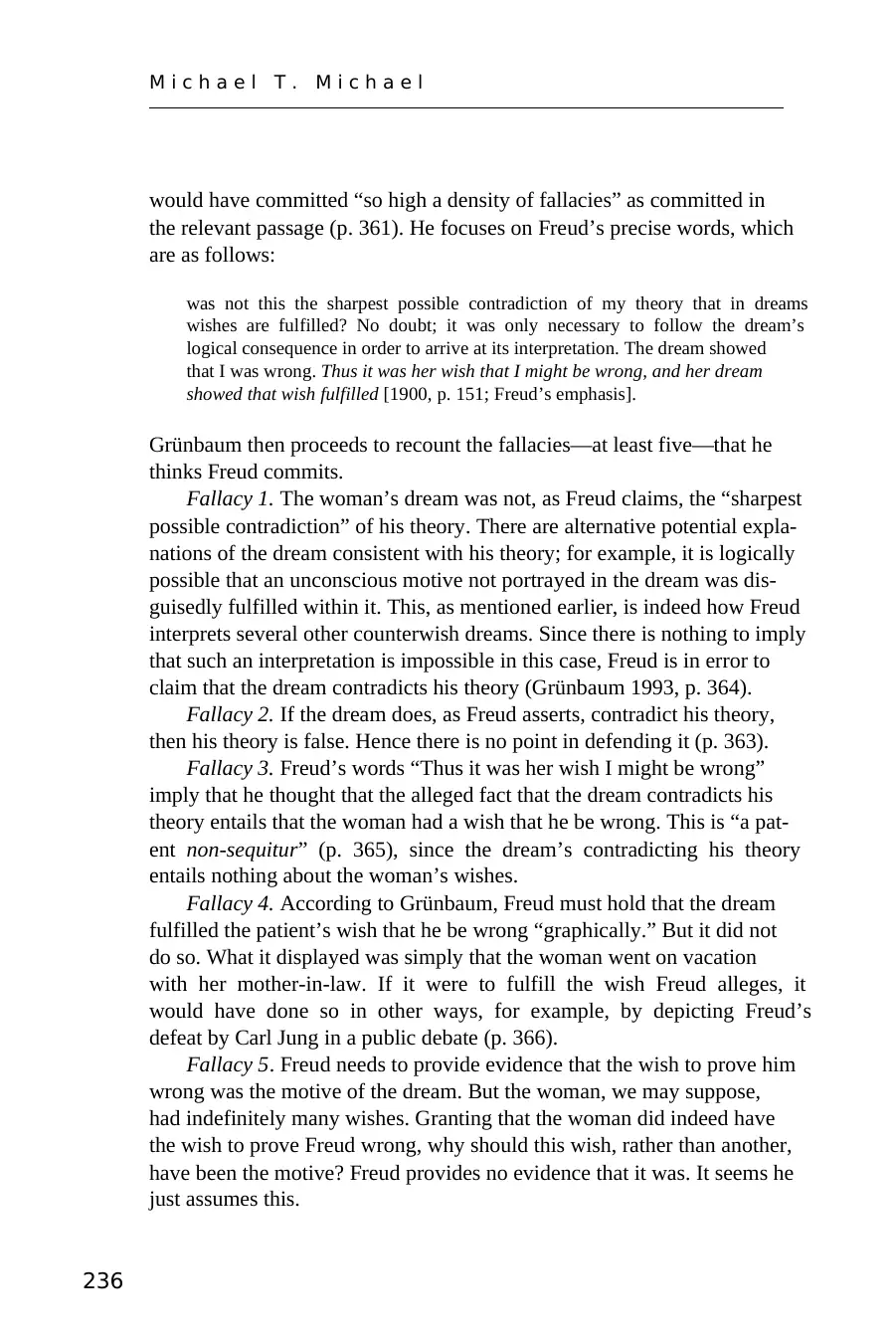
M i c h a e l T . M i c h a e l
236
would have committed “so high a density of fallacies” as committed in
the relevant passage (p. 361). He focuses on Freud’s precise words, which
are as follows:
was not this the sharpest possible contradiction of my theory that in dreams
wishes are fulfilled? No doubt; it was only necessary to follow the dream’s
logical consequence in order to arrive at its interpretation. The dream showed
that I was wrong. Thus it was her wish that I might be wrong, and her dream
showed that wish fulfilled [1900, p. 151; Freud’s emphasis].
Grünbaum then proceeds to recount the fallacies—at least five—that he
thinks Freud commits.
Fallacy 1. The woman’s dream was not, as Freud claims, the “sharpest
possible contradiction” of his theory. There are alternative potential expla-
nations of the dream consistent with his theory; for example, it is logically
possible that an unconscious motive not portrayed in the dream was dis-
guisedly fulfilled within it. This, as mentioned earlier, is indeed how Freud
interprets several other counterwish dreams. Since there is nothing to imply
that such an interpretation is impossible in this case, Freud is in error to
claim that the dream contradicts his theory (Grünbaum 1993, p. 364).
Fallacy 2. If the dream does, as Freud asserts, contradict his theory,
then his theory is false. Hence there is no point in defending it (p. 363).
Fallacy 3. Freud’s words “Thus it was her wish I might be wrong”
imply that he thought that the alleged fact that the dream contradicts his
theory entails that the woman had a wish that he be wrong. This is “a pat-
ent non-sequitur” (p. 365), since the dream’s contradicting his theory
entails nothing about the woman’s wishes.
Fallacy 4. According to Grünbaum, Freud must hold that the dream
fulfilled the patient’s wish that he be wrong “graphically.” But it did not
do so. What it displayed was simply that the woman went on vacation
with her mother-in-law. If it were to fulfill the wish Freud alleges, it
would have done so in other ways, for example, by depicting Freud’s
defeat by Carl Jung in a public debate (p. 366).
Fallacy 5. Freud needs to provide evidence that the wish to prove him
wrong was the motive of the dream. But the woman, we may suppose,
had indefinitely many wishes. Granting that the woman did indeed have
the wish to prove Freud wrong, why should this wish, rather than another,
have been the motive? Freud provides no evidence that it was. It seems he
just assumes this.
236
would have committed “so high a density of fallacies” as committed in
the relevant passage (p. 361). He focuses on Freud’s precise words, which
are as follows:
was not this the sharpest possible contradiction of my theory that in dreams
wishes are fulfilled? No doubt; it was only necessary to follow the dream’s
logical consequence in order to arrive at its interpretation. The dream showed
that I was wrong. Thus it was her wish that I might be wrong, and her dream
showed that wish fulfilled [1900, p. 151; Freud’s emphasis].
Grünbaum then proceeds to recount the fallacies—at least five—that he
thinks Freud commits.
Fallacy 1. The woman’s dream was not, as Freud claims, the “sharpest
possible contradiction” of his theory. There are alternative potential expla-
nations of the dream consistent with his theory; for example, it is logically
possible that an unconscious motive not portrayed in the dream was dis-
guisedly fulfilled within it. This, as mentioned earlier, is indeed how Freud
interprets several other counterwish dreams. Since there is nothing to imply
that such an interpretation is impossible in this case, Freud is in error to
claim that the dream contradicts his theory (Grünbaum 1993, p. 364).
Fallacy 2. If the dream does, as Freud asserts, contradict his theory,
then his theory is false. Hence there is no point in defending it (p. 363).
Fallacy 3. Freud’s words “Thus it was her wish I might be wrong”
imply that he thought that the alleged fact that the dream contradicts his
theory entails that the woman had a wish that he be wrong. This is “a pat-
ent non-sequitur” (p. 365), since the dream’s contradicting his theory
entails nothing about the woman’s wishes.
Fallacy 4. According to Grünbaum, Freud must hold that the dream
fulfilled the patient’s wish that he be wrong “graphically.” But it did not
do so. What it displayed was simply that the woman went on vacation
with her mother-in-law. If it were to fulfill the wish Freud alleges, it
would have done so in other ways, for example, by depicting Freud’s
defeat by Carl Jung in a public debate (p. 366).
Fallacy 5. Freud needs to provide evidence that the wish to prove him
wrong was the motive of the dream. But the woman, we may suppose,
had indefinitely many wishes. Granting that the woman did indeed have
the wish to prove Freud wrong, why should this wish, rather than another,
have been the motive? Freud provides no evidence that it was. It seems he
just assumes this.
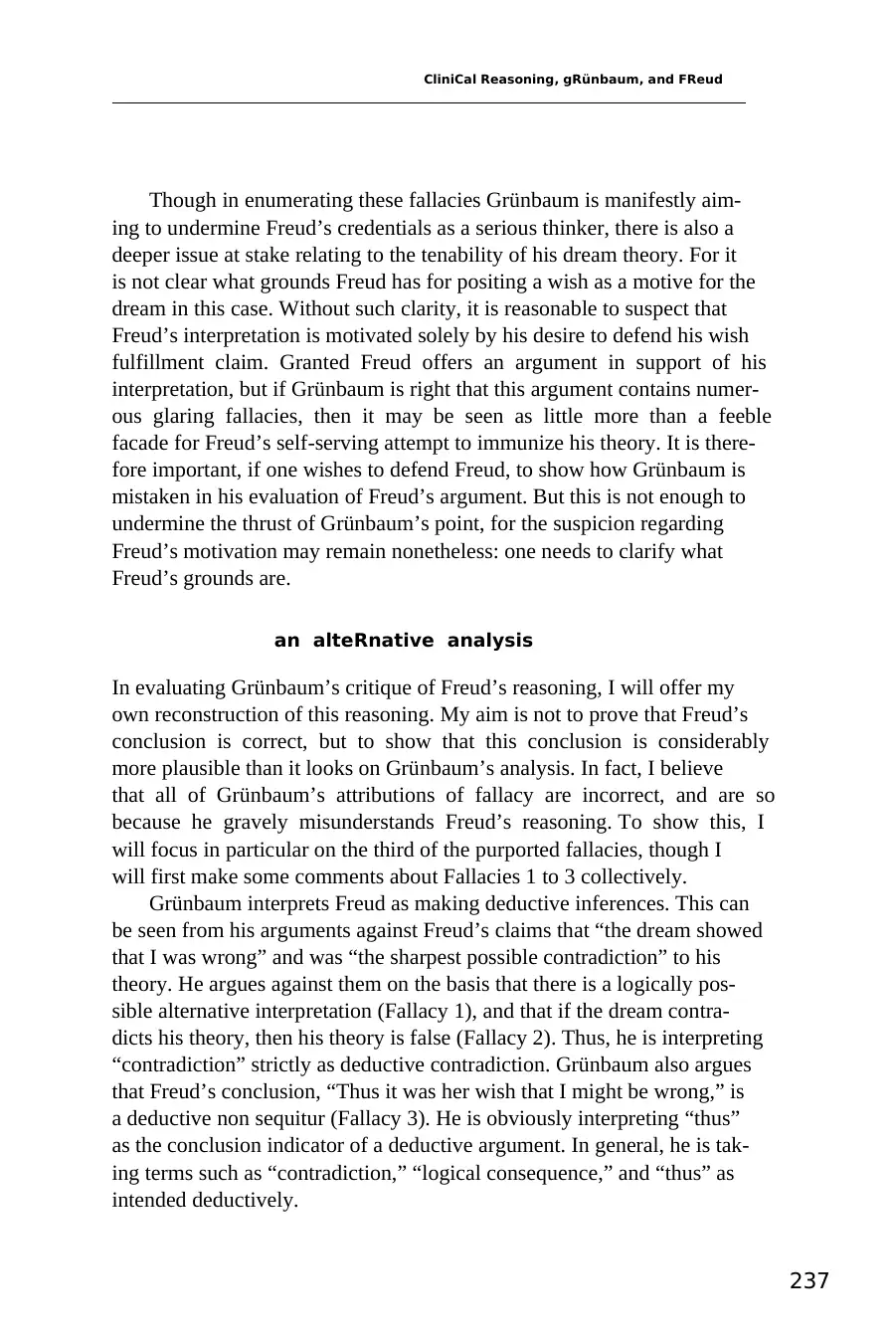
CliniCal Reasoning, gRünbaum, and FReud
237
Though in enumerating these fallacies Grünbaum is manifestly aim-
ing to undermine Freud’s credentials as a serious thinker, there is also a
deeper issue at stake relating to the tenability of his dream theory. For it
is not clear what grounds Freud has for positing a wish as a motive for the
dream in this case. Without such clarity, it is reasonable to suspect that
Freud’s interpretation is motivated solely by his desire to defend his wish
fulfillment claim. Granted Freud offers an argument in support of his
interpretation, but if Grünbaum is right that this argument contains numer-
ous glaring fallacies, then it may be seen as little more than a feeble
facade for Freud’s self-serving attempt to immunize his theory. It is there-
fore important, if one wishes to defend Freud, to show how Grünbaum is
mistaken in his evaluation of Freud’s argument. But this is not enough to
undermine the thrust of Grünbaum’s point, for the suspicion regarding
Freud’s motivation may remain nonetheless: one needs to clarify what
Freud’s grounds are.
an alteRnative analysis
In evaluating Grünbaum’s critique of Freud’s reasoning, I will offer my
own reconstruction of this reasoning. My aim is not to prove that Freud’s
conclusion is correct, but to show that this conclusion is considerably
more plausible than it looks on Grünbaum’s analysis. In fact, I believe
that all of Grünbaum’s attributions of fallacy are incorrect, and are so
because he gravely misunderstands Freud’s reasoning. To show this, I
will focus in particular on the third of the purported fallacies, though I
will first make some comments about Fallacies 1 to 3 collectively.
Grünbaum interprets Freud as making deductive inferences. This can
be seen from his arguments against Freud’s claims that “the dream showed
that I was wrong” and was “the sharpest possible contradiction” to his
theory. He argues against them on the basis that there is a logically pos-
sible alternative interpretation (Fallacy 1), and that if the dream contra-
dicts his theory, then his theory is false (Fallacy 2). Thus, he is interpreting
“contradiction” strictly as deductive contradiction. Grünbaum also argues
that Freud’s conclusion, “Thus it was her wish that I might be wrong,” is
a deductive non sequitur (Fallacy 3). He is obviously interpreting “thus”
as the conclusion indicator of a deductive argument. In general, he is tak-
ing terms such as “contradiction,” “logical consequence,” and “thus” as
intended deductively.
237
Though in enumerating these fallacies Grünbaum is manifestly aim-
ing to undermine Freud’s credentials as a serious thinker, there is also a
deeper issue at stake relating to the tenability of his dream theory. For it
is not clear what grounds Freud has for positing a wish as a motive for the
dream in this case. Without such clarity, it is reasonable to suspect that
Freud’s interpretation is motivated solely by his desire to defend his wish
fulfillment claim. Granted Freud offers an argument in support of his
interpretation, but if Grünbaum is right that this argument contains numer-
ous glaring fallacies, then it may be seen as little more than a feeble
facade for Freud’s self-serving attempt to immunize his theory. It is there-
fore important, if one wishes to defend Freud, to show how Grünbaum is
mistaken in his evaluation of Freud’s argument. But this is not enough to
undermine the thrust of Grünbaum’s point, for the suspicion regarding
Freud’s motivation may remain nonetheless: one needs to clarify what
Freud’s grounds are.
an alteRnative analysis
In evaluating Grünbaum’s critique of Freud’s reasoning, I will offer my
own reconstruction of this reasoning. My aim is not to prove that Freud’s
conclusion is correct, but to show that this conclusion is considerably
more plausible than it looks on Grünbaum’s analysis. In fact, I believe
that all of Grünbaum’s attributions of fallacy are incorrect, and are so
because he gravely misunderstands Freud’s reasoning. To show this, I
will focus in particular on the third of the purported fallacies, though I
will first make some comments about Fallacies 1 to 3 collectively.
Grünbaum interprets Freud as making deductive inferences. This can
be seen from his arguments against Freud’s claims that “the dream showed
that I was wrong” and was “the sharpest possible contradiction” to his
theory. He argues against them on the basis that there is a logically pos-
sible alternative interpretation (Fallacy 1), and that if the dream contra-
dicts his theory, then his theory is false (Fallacy 2). Thus, he is interpreting
“contradiction” strictly as deductive contradiction. Grünbaum also argues
that Freud’s conclusion, “Thus it was her wish that I might be wrong,” is
a deductive non sequitur (Fallacy 3). He is obviously interpreting “thus”
as the conclusion indicator of a deductive argument. In general, he is tak-
ing terms such as “contradiction,” “logical consequence,” and “thus” as
intended deductively.
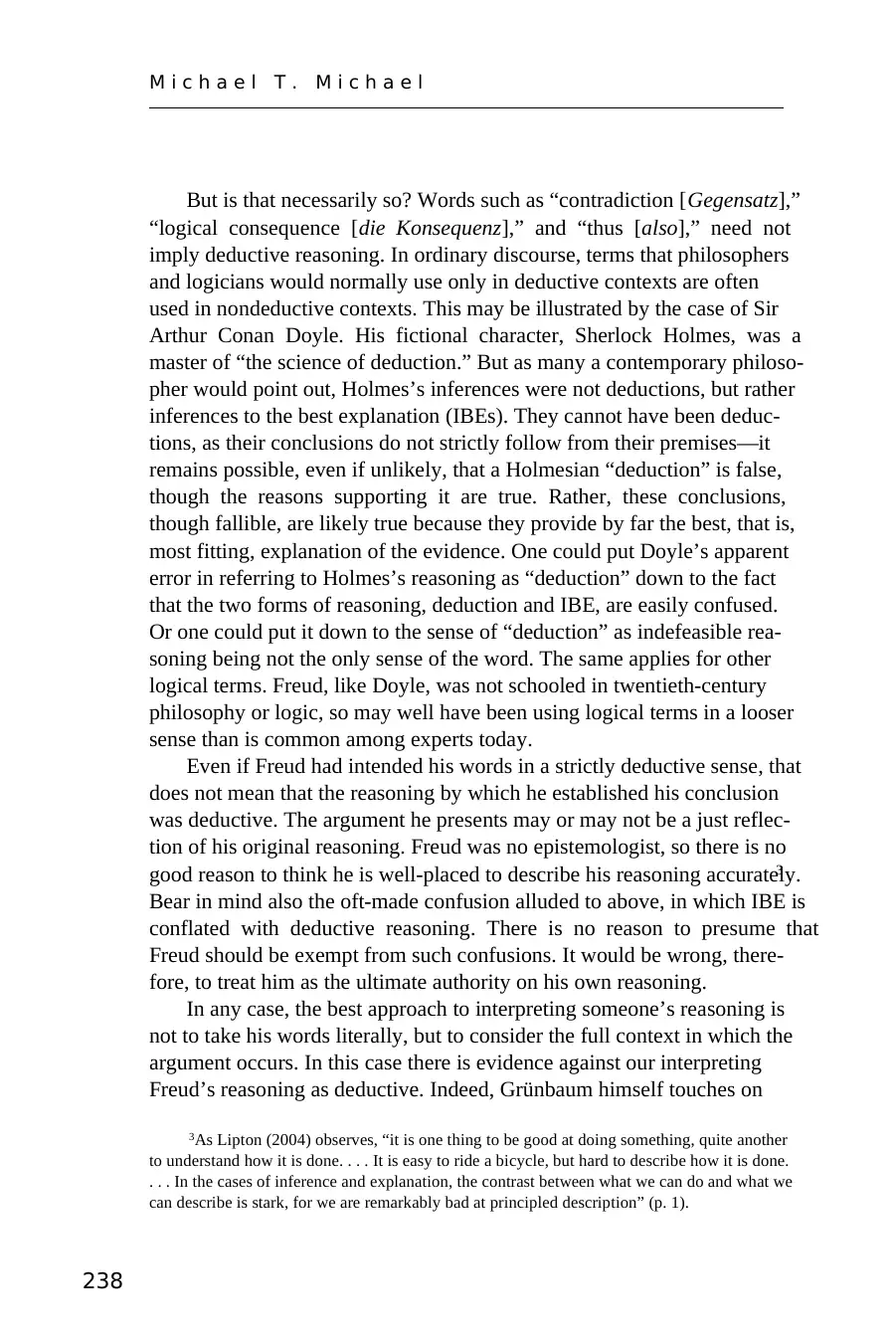
M i c h a e l T . M i c h a e l
238
But is that necessarily so? Words such as “contradiction [Gegensatz],”
“logical consequence [die Konsequenz],” and “thus [also],” need not
imply deductive reasoning. In ordinary discourse, terms that philosophers
and logicians would normally use only in deductive contexts are often
used in nondeductive contexts. This may be illustrated by the case of Sir
Arthur Conan Doyle. His fictional character, Sherlock Holmes, was a
master of “the science of deduction.” But as many a contemporary philoso-
pher would point out, Holmes’s inferences were not deductions, but rather
inferences to the best explanation (IBEs). They cannot have been deduc-
tions, as their conclusions do not strictly follow from their premises—it
remains possible, even if unlikely, that a Holmesian “deduction” is false,
though the reasons supporting it are true. Rather, these conclusions,
though fallible, are likely true because they provide by far the best, that is,
most fitting, explanation of the evidence. One could put Doyle’s apparent
error in referring to Holmes’s reasoning as “deduction” down to the fact
that the two forms of reasoning, deduction and IBE, are easily confused.
Or one could put it down to the sense of “deduction” as indefeasible rea-
soning being not the only sense of the word. The same applies for other
logical terms. Freud, like Doyle, was not schooled in twentieth-century
philosophy or logic, so may well have been using logical terms in a looser
sense than is common among experts today.
Even if Freud had intended his words in a strictly deductive sense, that
does not mean that the reasoning by which he established his conclusion
was deductive. The argument he presents may or may not be a just reflec-
tion of his original reasoning. Freud was no epistemologist, so there is no
good reason to think he is well-placed to describe his reasoning accurately.3
Bear in mind also the oft-made confusion alluded to above, in which IBE is
conflated with deductive reasoning. There is no reason to presume that
Freud should be exempt from such confusions. It would be wrong, there-
fore, to treat him as the ultimate authority on his own reasoning.
In any case, the best approach to interpreting someone’s reasoning is
not to take his words literally, but to consider the full context in which the
argument occurs. In this case there is evidence against our interpreting
Freud’s reasoning as deductive. Indeed, Grünbaum himself touches on
3As Lipton (2004) observes, “it is one thing to be good at doing something, quite another
to understand how it is done. . . . It is easy to ride a bicycle, but hard to describe how it is done.
. . . In the cases of inference and explanation, the contrast between what we can do and what we
can describe is stark, for we are remarkably bad at principled description” (p. 1).
238
But is that necessarily so? Words such as “contradiction [Gegensatz],”
“logical consequence [die Konsequenz],” and “thus [also],” need not
imply deductive reasoning. In ordinary discourse, terms that philosophers
and logicians would normally use only in deductive contexts are often
used in nondeductive contexts. This may be illustrated by the case of Sir
Arthur Conan Doyle. His fictional character, Sherlock Holmes, was a
master of “the science of deduction.” But as many a contemporary philoso-
pher would point out, Holmes’s inferences were not deductions, but rather
inferences to the best explanation (IBEs). They cannot have been deduc-
tions, as their conclusions do not strictly follow from their premises—it
remains possible, even if unlikely, that a Holmesian “deduction” is false,
though the reasons supporting it are true. Rather, these conclusions,
though fallible, are likely true because they provide by far the best, that is,
most fitting, explanation of the evidence. One could put Doyle’s apparent
error in referring to Holmes’s reasoning as “deduction” down to the fact
that the two forms of reasoning, deduction and IBE, are easily confused.
Or one could put it down to the sense of “deduction” as indefeasible rea-
soning being not the only sense of the word. The same applies for other
logical terms. Freud, like Doyle, was not schooled in twentieth-century
philosophy or logic, so may well have been using logical terms in a looser
sense than is common among experts today.
Even if Freud had intended his words in a strictly deductive sense, that
does not mean that the reasoning by which he established his conclusion
was deductive. The argument he presents may or may not be a just reflec-
tion of his original reasoning. Freud was no epistemologist, so there is no
good reason to think he is well-placed to describe his reasoning accurately.3
Bear in mind also the oft-made confusion alluded to above, in which IBE is
conflated with deductive reasoning. There is no reason to presume that
Freud should be exempt from such confusions. It would be wrong, there-
fore, to treat him as the ultimate authority on his own reasoning.
In any case, the best approach to interpreting someone’s reasoning is
not to take his words literally, but to consider the full context in which the
argument occurs. In this case there is evidence against our interpreting
Freud’s reasoning as deductive. Indeed, Grünbaum himself touches on
3As Lipton (2004) observes, “it is one thing to be good at doing something, quite another
to understand how it is done. . . . It is easy to ride a bicycle, but hard to describe how it is done.
. . . In the cases of inference and explanation, the contrast between what we can do and what we
can describe is stark, for we are remarkably bad at principled description” (p. 1).
Secure Best Marks with AI Grader
Need help grading? Try our AI Grader for instant feedback on your assignments.
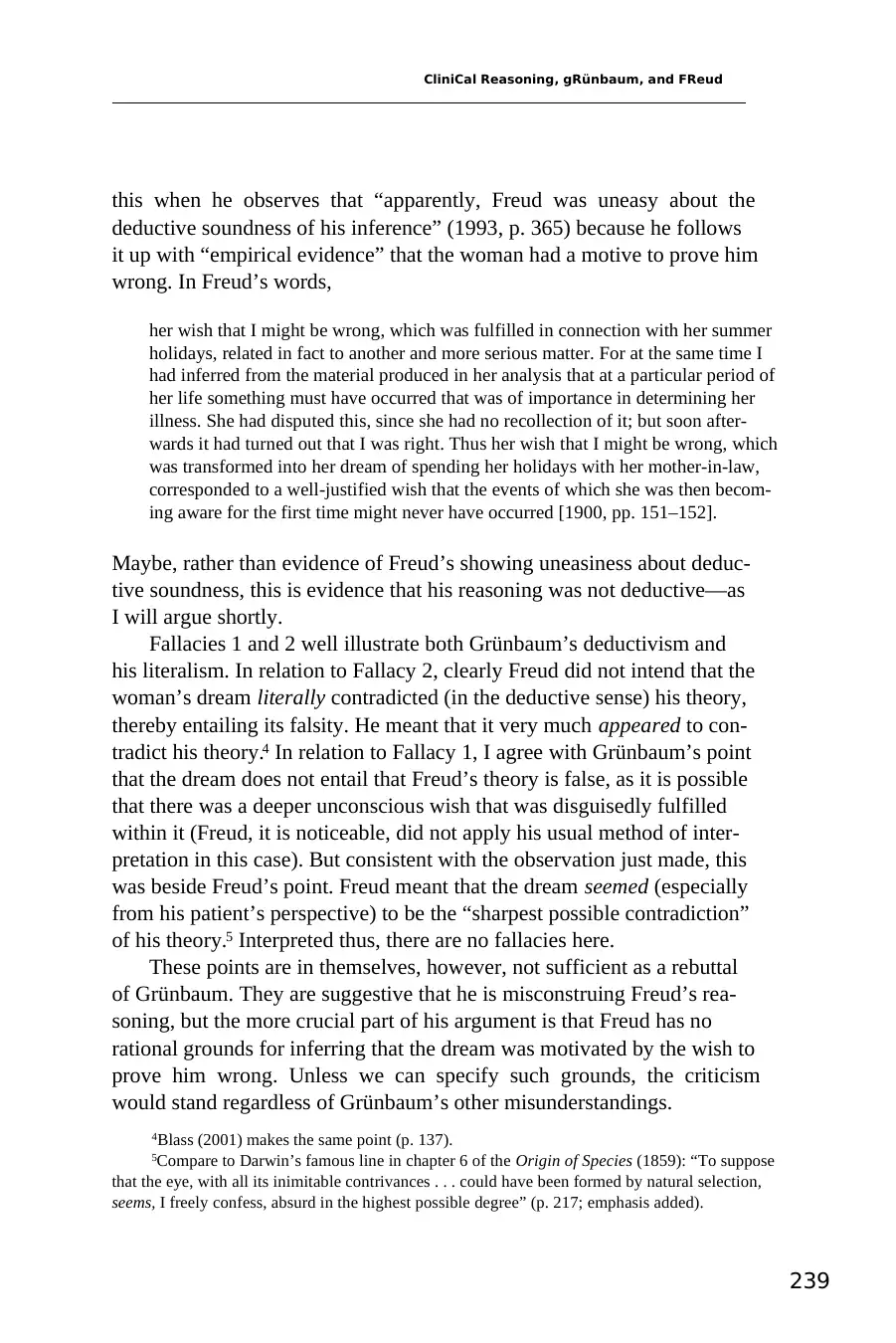
CliniCal Reasoning, gRünbaum, and FReud
239
this when he observes that “apparently, Freud was uneasy about the
deductive soundness of his inference” (1993, p. 365) because he follows
it up with “empirical evidence” that the woman had a motive to prove him
wrong. In Freud’s words,
her wish that I might be wrong, which was fulfilled in connection with her summer
holidays, related in fact to another and more serious matter. For at the same time I
had inferred from the material produced in her analysis that at a particular period of
her life something must have occurred that was of importance in determining her
illness. She had disputed this, since she had no recollection of it; but soon after-
wards it had turned out that I was right. Thus her wish that I might be wrong, which
was transformed into her dream of spending her holidays with her mother-in-law,
corresponded to a well-justified wish that the events of which she was then becom-
ing aware for the first time might never have occurred [1900, pp. 151–152].
Maybe, rather than evidence of Freud’s showing uneasiness about deduc-
tive soundness, this is evidence that his reasoning was not deductive—as
I will argue shortly.
Fallacies 1 and 2 well illustrate both Grünbaum’s deductivism and
his literalism. In relation to Fallacy 2, clearly Freud did not intend that the
woman’s dream literally contradicted (in the deductive sense) his theory,
thereby entailing its falsity. He meant that it very much appeared to con-
tradict his theory.4 In relation to Fallacy 1, I agree with Grünbaum’s point
that the dream does not entail that Freud’s theory is false, as it is possible
that there was a deeper unconscious wish that was disguisedly fulfilled
within it (Freud, it is noticeable, did not apply his usual method of inter-
pretation in this case). But consistent with the observation just made, this
was beside Freud’s point. Freud meant that the dream seemed (especially
from his patient’s perspective) to be the “sharpest possible contradiction”
of his theory.5 Interpreted thus, there are no fallacies here.
These points are in themselves, however, not sufficient as a rebuttal
of Grünbaum. They are suggestive that he is misconstruing Freud’s rea-
soning, but the more crucial part of his argument is that Freud has no
rational grounds for inferring that the dream was motivated by the wish to
prove him wrong. Unless we can specify such grounds, the criticism
would stand regardless of Grünbaum’s other misunderstandings.
4Blass (2001) makes the same point (p. 137).
5Compare to Darwin’s famous line in chapter 6 of the Origin of Species (1859): “To suppose
that the eye, with all its inimitable contrivances . . . could have been formed by natural selection,
seems, I freely confess, absurd in the highest possible degree” (p. 217; emphasis added).
239
this when he observes that “apparently, Freud was uneasy about the
deductive soundness of his inference” (1993, p. 365) because he follows
it up with “empirical evidence” that the woman had a motive to prove him
wrong. In Freud’s words,
her wish that I might be wrong, which was fulfilled in connection with her summer
holidays, related in fact to another and more serious matter. For at the same time I
had inferred from the material produced in her analysis that at a particular period of
her life something must have occurred that was of importance in determining her
illness. She had disputed this, since she had no recollection of it; but soon after-
wards it had turned out that I was right. Thus her wish that I might be wrong, which
was transformed into her dream of spending her holidays with her mother-in-law,
corresponded to a well-justified wish that the events of which she was then becom-
ing aware for the first time might never have occurred [1900, pp. 151–152].
Maybe, rather than evidence of Freud’s showing uneasiness about deduc-
tive soundness, this is evidence that his reasoning was not deductive—as
I will argue shortly.
Fallacies 1 and 2 well illustrate both Grünbaum’s deductivism and
his literalism. In relation to Fallacy 2, clearly Freud did not intend that the
woman’s dream literally contradicted (in the deductive sense) his theory,
thereby entailing its falsity. He meant that it very much appeared to con-
tradict his theory.4 In relation to Fallacy 1, I agree with Grünbaum’s point
that the dream does not entail that Freud’s theory is false, as it is possible
that there was a deeper unconscious wish that was disguisedly fulfilled
within it (Freud, it is noticeable, did not apply his usual method of inter-
pretation in this case). But consistent with the observation just made, this
was beside Freud’s point. Freud meant that the dream seemed (especially
from his patient’s perspective) to be the “sharpest possible contradiction”
of his theory.5 Interpreted thus, there are no fallacies here.
These points are in themselves, however, not sufficient as a rebuttal
of Grünbaum. They are suggestive that he is misconstruing Freud’s rea-
soning, but the more crucial part of his argument is that Freud has no
rational grounds for inferring that the dream was motivated by the wish to
prove him wrong. Unless we can specify such grounds, the criticism
would stand regardless of Grünbaum’s other misunderstandings.
4Blass (2001) makes the same point (p. 137).
5Compare to Darwin’s famous line in chapter 6 of the Origin of Species (1859): “To suppose
that the eye, with all its inimitable contrivances . . . could have been formed by natural selection,
seems, I freely confess, absurd in the highest possible degree” (p. 217; emphasis added).
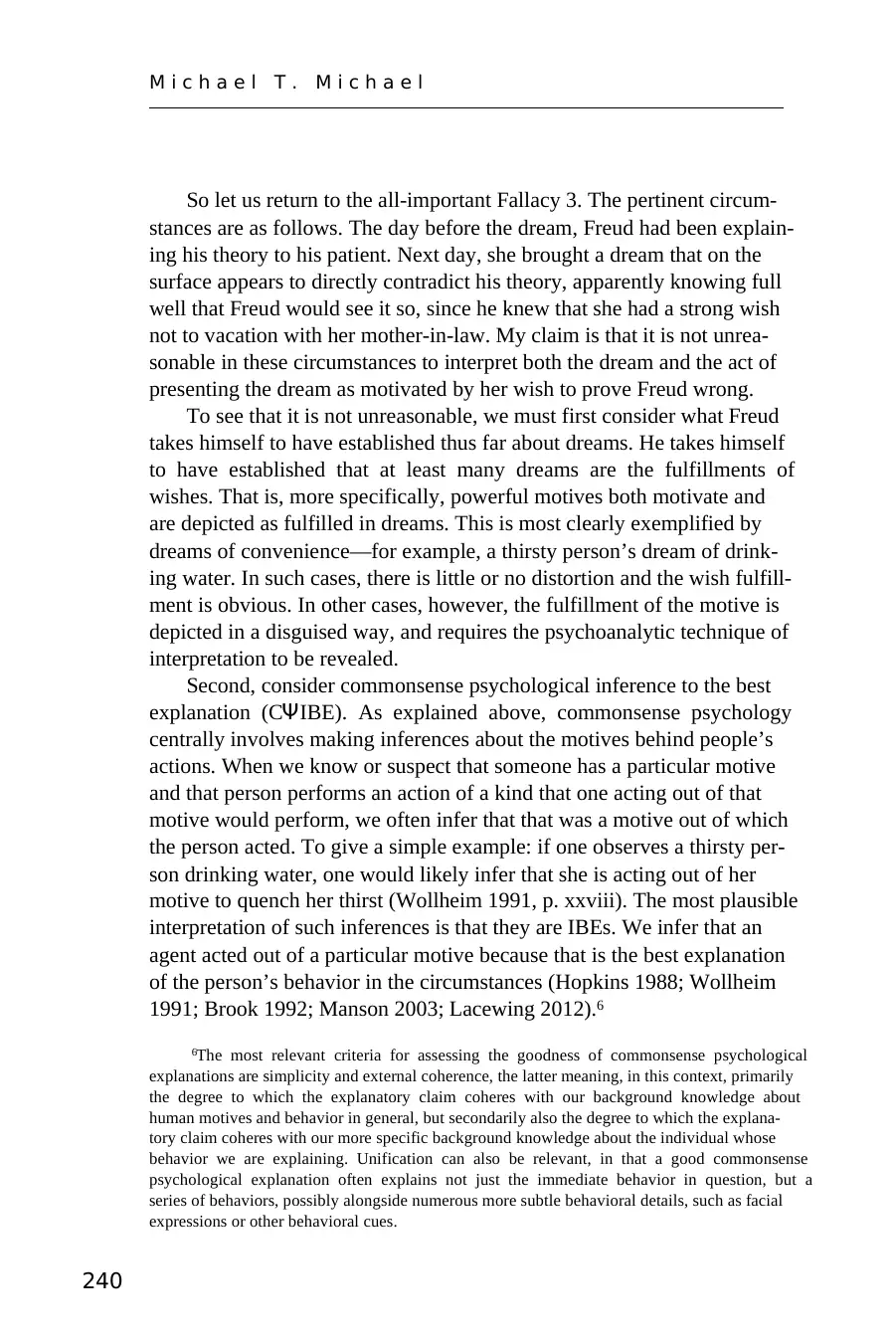
M i c h a e l T . M i c h a e l
240
So let us return to the all-important Fallacy 3. The pertinent circum-
stances are as follows. The day before the dream, Freud had been explain-
ing his theory to his patient. Next day, she brought a dream that on the
surface appears to directly contradict his theory, apparently knowing full
well that Freud would see it so, since he knew that she had a strong wish
not to vacation with her mother-in-law. My claim is that it is not unrea-
sonable in these circumstances to interpret both the dream and the act of
presenting the dream as motivated by her wish to prove Freud wrong.
To see that it is not unreasonable, we must first consider what Freud
takes himself to have established thus far about dreams. He takes himself
to have established that at least many dreams are the fulfillments of
wishes. That is, more specifically, powerful motives both motivate and
are depicted as fulfilled in dreams. This is most clearly exemplified by
dreams of convenience—for example, a thirsty person’s dream of drink-
ing water. In such cases, there is little or no distortion and the wish fulfill-
ment is obvious. In other cases, however, the fulfillment of the motive is
depicted in a disguised way, and requires the psychoanalytic technique of
interpretation to be revealed.
Second, consider commonsense psychological inference to the best
explanation (CΨIBE). As explained above, commonsense psychology
centrally involves making inferences about the motives behind people’s
actions. When we know or suspect that someone has a particular motive
and that person performs an action of a kind that one acting out of that
motive would perform, we often infer that that was a motive out of which
the person acted. To give a simple example: if one observes a thirsty per-
son drinking water, one would likely infer that she is acting out of her
motive to quench her thirst (Wollheim 1991, p. xxviii). The most plausible
interpretation of such inferences is that they are IBEs. We infer that an
agent acted out of a particular motive because that is the best explanation
of the person’s behavior in the circumstances (Hopkins 1988; Wollheim
1991; Brook 1992; Manson 2003; Lacewing 2012).6
6The most relevant criteria for assessing the goodness of commonsense psychological
explanations are simplicity and external coherence, the latter meaning, in this context, primarily
the degree to which the explanatory claim coheres with our background knowledge about
human motives and behavior in general, but secondarily also the degree to which the explana-
tory claim coheres with our more specific background knowledge about the individual whose
behavior we are explaining. Unification can also be relevant, in that a good commonsense
psychological explanation often explains not just the immediate behavior in question, but a
series of behaviors, possibly alongside numerous more subtle behavioral details, such as facial
expressions or other behavioral cues.
240
So let us return to the all-important Fallacy 3. The pertinent circum-
stances are as follows. The day before the dream, Freud had been explain-
ing his theory to his patient. Next day, she brought a dream that on the
surface appears to directly contradict his theory, apparently knowing full
well that Freud would see it so, since he knew that she had a strong wish
not to vacation with her mother-in-law. My claim is that it is not unrea-
sonable in these circumstances to interpret both the dream and the act of
presenting the dream as motivated by her wish to prove Freud wrong.
To see that it is not unreasonable, we must first consider what Freud
takes himself to have established thus far about dreams. He takes himself
to have established that at least many dreams are the fulfillments of
wishes. That is, more specifically, powerful motives both motivate and
are depicted as fulfilled in dreams. This is most clearly exemplified by
dreams of convenience—for example, a thirsty person’s dream of drink-
ing water. In such cases, there is little or no distortion and the wish fulfill-
ment is obvious. In other cases, however, the fulfillment of the motive is
depicted in a disguised way, and requires the psychoanalytic technique of
interpretation to be revealed.
Second, consider commonsense psychological inference to the best
explanation (CΨIBE). As explained above, commonsense psychology
centrally involves making inferences about the motives behind people’s
actions. When we know or suspect that someone has a particular motive
and that person performs an action of a kind that one acting out of that
motive would perform, we often infer that that was a motive out of which
the person acted. To give a simple example: if one observes a thirsty per-
son drinking water, one would likely infer that she is acting out of her
motive to quench her thirst (Wollheim 1991, p. xxviii). The most plausible
interpretation of such inferences is that they are IBEs. We infer that an
agent acted out of a particular motive because that is the best explanation
of the person’s behavior in the circumstances (Hopkins 1988; Wollheim
1991; Brook 1992; Manson 2003; Lacewing 2012).6
6The most relevant criteria for assessing the goodness of commonsense psychological
explanations are simplicity and external coherence, the latter meaning, in this context, primarily
the degree to which the explanatory claim coheres with our background knowledge about
human motives and behavior in general, but secondarily also the degree to which the explana-
tory claim coheres with our more specific background knowledge about the individual whose
behavior we are explaining. Unification can also be relevant, in that a good commonsense
psychological explanation often explains not just the immediate behavior in question, but a
series of behaviors, possibly alongside numerous more subtle behavioral details, such as facial
expressions or other behavioral cues.
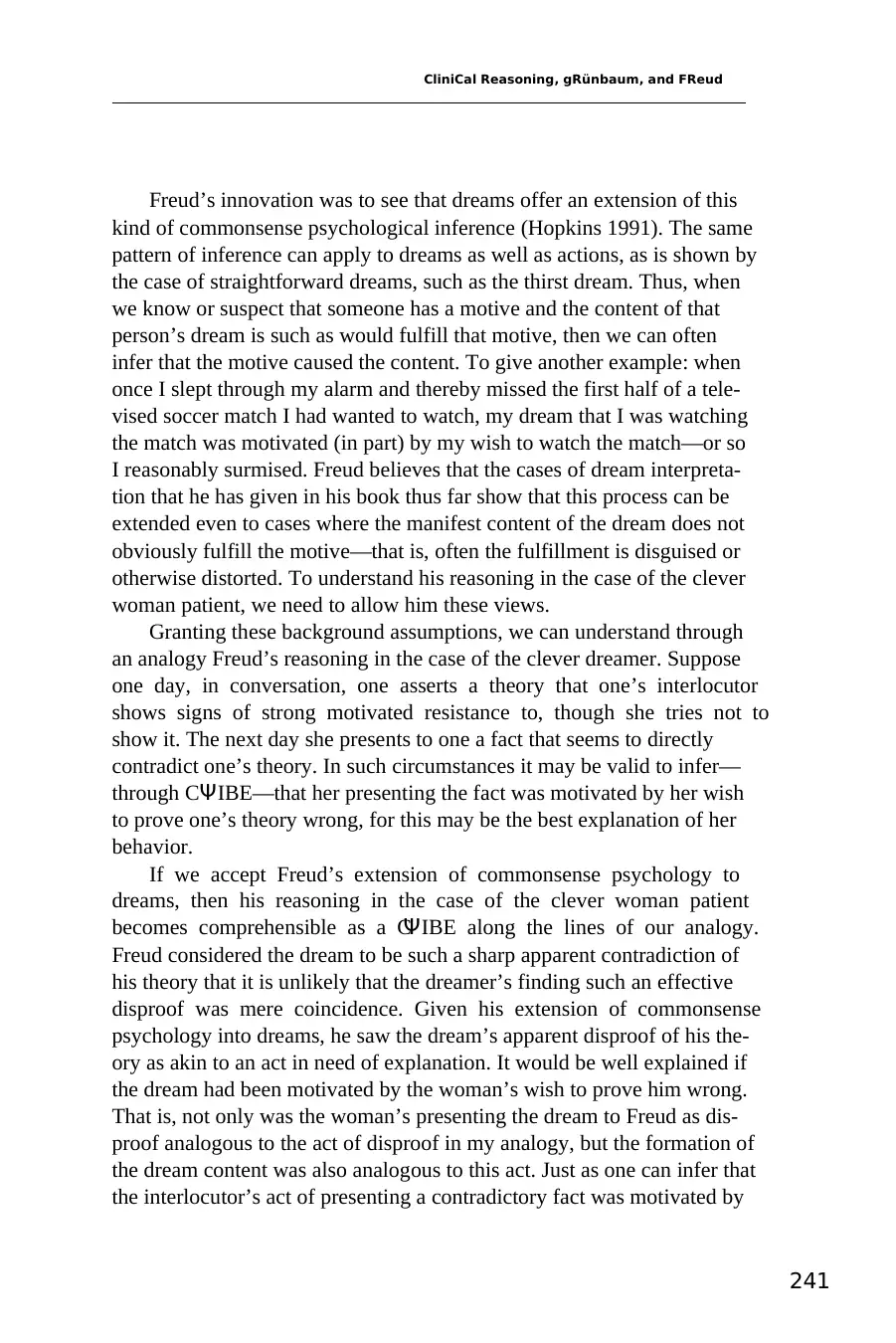
CliniCal Reasoning, gRünbaum, and FReud
241
Freud’s innovation was to see that dreams offer an extension of this
kind of commonsense psychological inference (Hopkins 1991). The same
pattern of inference can apply to dreams as well as actions, as is shown by
the case of straightforward dreams, such as the thirst dream. Thus, when
we know or suspect that someone has a motive and the content of that
person’s dream is such as would fulfill that motive, then we can often
infer that the motive caused the content. To give another example: when
once I slept through my alarm and thereby missed the first half of a tele-
vised soccer match I had wanted to watch, my dream that I was watching
the match was motivated (in part) by my wish to watch the match—or so
I reasonably surmised. Freud believes that the cases of dream interpreta-
tion that he has given in his book thus far show that this process can be
extended even to cases where the manifest content of the dream does not
obviously fulfill the motive—that is, often the fulfillment is disguised or
otherwise distorted. To understand his reasoning in the case of the clever
woman patient, we need to allow him these views.
Granting these background assumptions, we can understand through
an analogy Freud’s reasoning in the case of the clever dreamer. Suppose
one day, in conversation, one asserts a theory that one’s interlocutor
shows signs of strong motivated resistance to, though she tries not to
show it. The next day she presents to one a fact that seems to directly
contradict one’s theory. In such circumstances it may be valid to infer—
through CΨIBE—that her presenting the fact was motivated by her wish
to prove one’s theory wrong, for this may be the best explanation of her
behavior.
If we accept Freud’s extension of commonsense psychology to
dreams, then his reasoning in the case of the clever woman patient
becomes comprehensible as a CΨIBE along the lines of our analogy.
Freud considered the dream to be such a sharp apparent contradiction of
his theory that it is unlikely that the dreamer’s finding such an effective
disproof was mere coincidence. Given his extension of commonsense
psychology into dreams, he saw the dream’s apparent disproof of his the-
ory as akin to an act in need of explanation. It would be well explained if
the dream had been motivated by the woman’s wish to prove him wrong.
That is, not only was the woman’s presenting the dream to Freud as dis-
proof analogous to the act of disproof in my analogy, but the formation of
the dream content was also analogous to this act. Just as one can infer that
the interlocutor’s act of presenting a contradictory fact was motivated by
241
Freud’s innovation was to see that dreams offer an extension of this
kind of commonsense psychological inference (Hopkins 1991). The same
pattern of inference can apply to dreams as well as actions, as is shown by
the case of straightforward dreams, such as the thirst dream. Thus, when
we know or suspect that someone has a motive and the content of that
person’s dream is such as would fulfill that motive, then we can often
infer that the motive caused the content. To give another example: when
once I slept through my alarm and thereby missed the first half of a tele-
vised soccer match I had wanted to watch, my dream that I was watching
the match was motivated (in part) by my wish to watch the match—or so
I reasonably surmised. Freud believes that the cases of dream interpreta-
tion that he has given in his book thus far show that this process can be
extended even to cases where the manifest content of the dream does not
obviously fulfill the motive—that is, often the fulfillment is disguised or
otherwise distorted. To understand his reasoning in the case of the clever
woman patient, we need to allow him these views.
Granting these background assumptions, we can understand through
an analogy Freud’s reasoning in the case of the clever dreamer. Suppose
one day, in conversation, one asserts a theory that one’s interlocutor
shows signs of strong motivated resistance to, though she tries not to
show it. The next day she presents to one a fact that seems to directly
contradict one’s theory. In such circumstances it may be valid to infer—
through CΨIBE—that her presenting the fact was motivated by her wish
to prove one’s theory wrong, for this may be the best explanation of her
behavior.
If we accept Freud’s extension of commonsense psychology to
dreams, then his reasoning in the case of the clever woman patient
becomes comprehensible as a CΨIBE along the lines of our analogy.
Freud considered the dream to be such a sharp apparent contradiction of
his theory that it is unlikely that the dreamer’s finding such an effective
disproof was mere coincidence. Given his extension of commonsense
psychology into dreams, he saw the dream’s apparent disproof of his the-
ory as akin to an act in need of explanation. It would be well explained if
the dream had been motivated by the woman’s wish to prove him wrong.
That is, not only was the woman’s presenting the dream to Freud as dis-
proof analogous to the act of disproof in my analogy, but the formation of
the dream content was also analogous to this act. Just as one can infer that
the interlocutor’s act of presenting a contradictory fact was motivated by
Paraphrase This Document
Need a fresh take? Get an instant paraphrase of this document with our AI Paraphraser
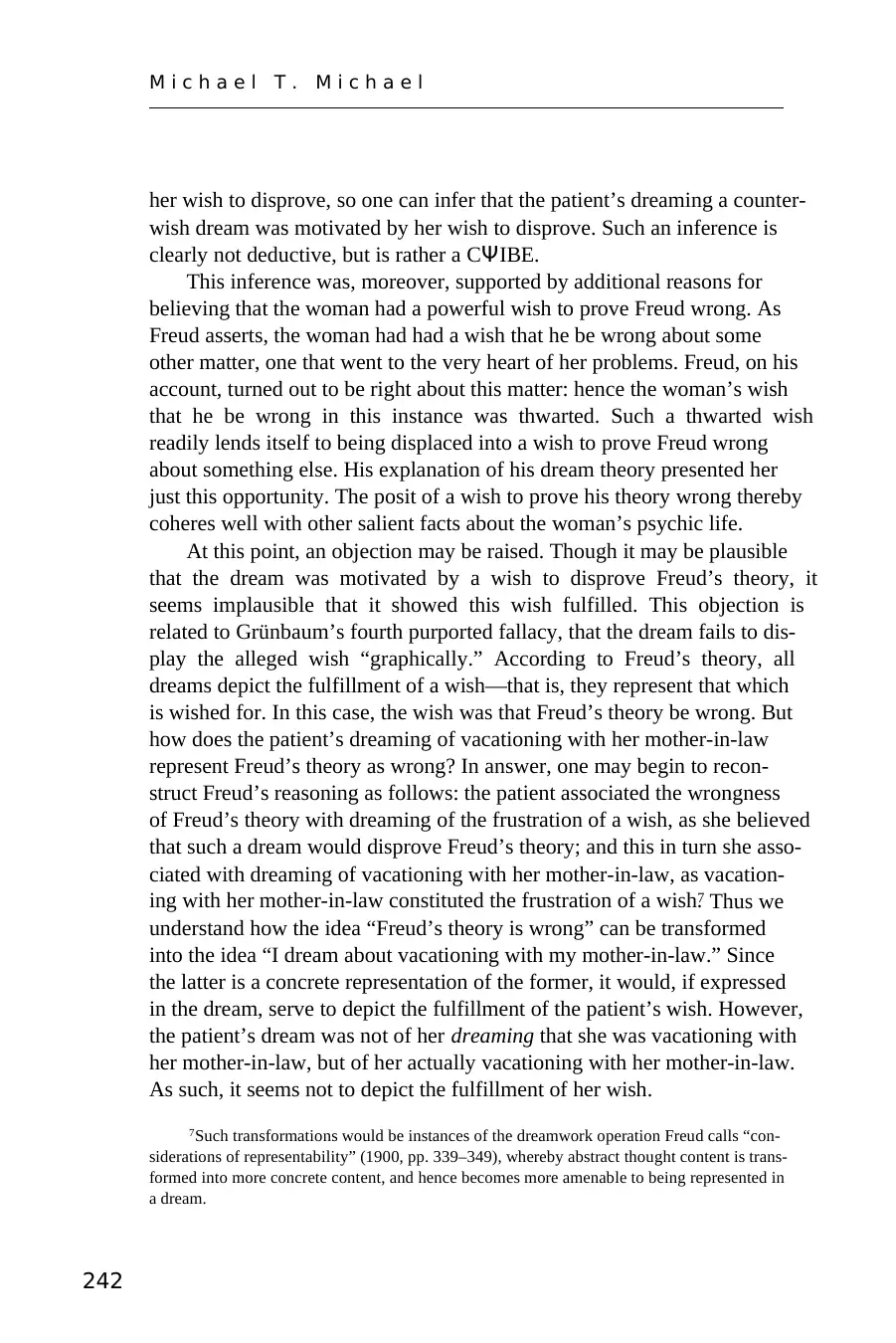
M i c h a e l T . M i c h a e l
242
her wish to disprove, so one can infer that the patient’s dreaming a counter-
wish dream was motivated by her wish to disprove. Such an inference is
clearly not deductive, but is rather a CΨIBE.
This inference was, moreover, supported by additional reasons for
believing that the woman had a powerful wish to prove Freud wrong. As
Freud asserts, the woman had had a wish that he be wrong about some
other matter, one that went to the very heart of her problems. Freud, on his
account, turned out to be right about this matter: hence the woman’s wish
that he be wrong in this instance was thwarted. Such a thwarted wish
readily lends itself to being displaced into a wish to prove Freud wrong
about something else. His explanation of his dream theory presented her
just this opportunity. The posit of a wish to prove his theory wrong thereby
coheres well with other salient facts about the woman’s psychic life.
At this point, an objection may be raised. Though it may be plausible
that the dream was motivated by a wish to disprove Freud’s theory, it
seems implausible that it showed this wish fulfilled. This objection is
related to Grünbaum’s fourth purported fallacy, that the dream fails to dis-
play the alleged wish “graphically.” According to Freud’s theory, all
dreams depict the fulfillment of a wish—that is, they represent that which
is wished for. In this case, the wish was that Freud’s theory be wrong. But
how does the patient’s dreaming of vacationing with her mother-in-law
represent Freud’s theory as wrong? In answer, one may begin to recon-
struct Freud’s reasoning as follows: the patient associated the wrongness
of Freud’s theory with dreaming of the frustration of a wish, as she believed
that such a dream would disprove Freud’s theory; and this in turn she asso-
ciated with dreaming of vacationing with her mother-in-law, as vacation-
ing with her mother-in-law constituted the frustration of a wish.7 Thus we
understand how the idea “Freud’s theory is wrong” can be transformed
into the idea “I dream about vacationing with my mother-in-law.” Since
the latter is a concrete representation of the former, it would, if expressed
in the dream, serve to depict the fulfillment of the patient’s wish. However,
the patient’s dream was not of her dreaming that she was vacationing with
her mother-in-law, but of her actually vacationing with her mother-in-law.
As such, it seems not to depict the fulfillment of her wish.
7Such transformations would be instances of the dreamwork operation Freud calls “con-
siderations of representability” (1900, pp. 339–349), whereby abstract thought content is trans-
formed into more concrete content, and hence becomes more amenable to being represented in
a dream.
242
her wish to disprove, so one can infer that the patient’s dreaming a counter-
wish dream was motivated by her wish to disprove. Such an inference is
clearly not deductive, but is rather a CΨIBE.
This inference was, moreover, supported by additional reasons for
believing that the woman had a powerful wish to prove Freud wrong. As
Freud asserts, the woman had had a wish that he be wrong about some
other matter, one that went to the very heart of her problems. Freud, on his
account, turned out to be right about this matter: hence the woman’s wish
that he be wrong in this instance was thwarted. Such a thwarted wish
readily lends itself to being displaced into a wish to prove Freud wrong
about something else. His explanation of his dream theory presented her
just this opportunity. The posit of a wish to prove his theory wrong thereby
coheres well with other salient facts about the woman’s psychic life.
At this point, an objection may be raised. Though it may be plausible
that the dream was motivated by a wish to disprove Freud’s theory, it
seems implausible that it showed this wish fulfilled. This objection is
related to Grünbaum’s fourth purported fallacy, that the dream fails to dis-
play the alleged wish “graphically.” According to Freud’s theory, all
dreams depict the fulfillment of a wish—that is, they represent that which
is wished for. In this case, the wish was that Freud’s theory be wrong. But
how does the patient’s dreaming of vacationing with her mother-in-law
represent Freud’s theory as wrong? In answer, one may begin to recon-
struct Freud’s reasoning as follows: the patient associated the wrongness
of Freud’s theory with dreaming of the frustration of a wish, as she believed
that such a dream would disprove Freud’s theory; and this in turn she asso-
ciated with dreaming of vacationing with her mother-in-law, as vacation-
ing with her mother-in-law constituted the frustration of a wish.7 Thus we
understand how the idea “Freud’s theory is wrong” can be transformed
into the idea “I dream about vacationing with my mother-in-law.” Since
the latter is a concrete representation of the former, it would, if expressed
in the dream, serve to depict the fulfillment of the patient’s wish. However,
the patient’s dream was not of her dreaming that she was vacationing with
her mother-in-law, but of her actually vacationing with her mother-in-law.
As such, it seems not to depict the fulfillment of her wish.
7Such transformations would be instances of the dreamwork operation Freud calls “con-
siderations of representability” (1900, pp. 339–349), whereby abstract thought content is trans-
formed into more concrete content, and hence becomes more amenable to being represented in
a dream.
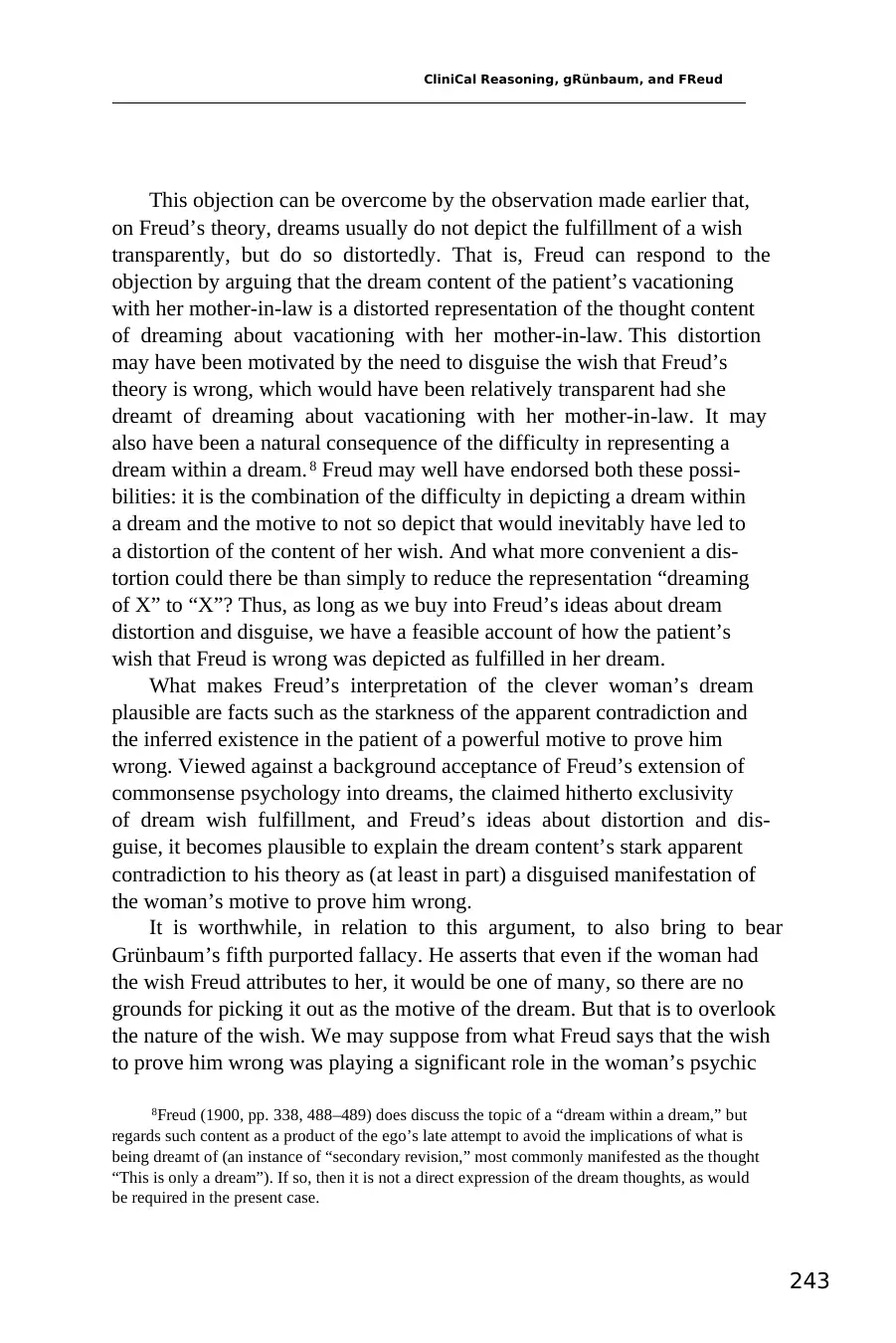
CliniCal Reasoning, gRünbaum, and FReud
243
This objection can be overcome by the observation made earlier that,
on Freud’s theory, dreams usually do not depict the fulfillment of a wish
transparently, but do so distortedly. That is, Freud can respond to the
objection by arguing that the dream content of the patient’s vacationing
with her mother-in-law is a distorted representation of the thought content
of dreaming about vacationing with her mother-in-law. This distortion
may have been motivated by the need to disguise the wish that Freud’s
theory is wrong, which would have been relatively transparent had she
dreamt of dreaming about vacationing with her mother-in-law. It may
also have been a natural consequence of the difficulty in representing a
dream within a dream. 8 Freud may well have endorsed both these possi-
bilities: it is the combination of the difficulty in depicting a dream within
a dream and the motive to not so depict that would inevitably have led to
a distortion of the content of her wish. And what more convenient a dis-
tortion could there be than simply to reduce the representation “dreaming
of X” to “X”? Thus, as long as we buy into Freud’s ideas about dream
distortion and disguise, we have a feasible account of how the patient’s
wish that Freud is wrong was depicted as fulfilled in her dream.
What makes Freud’s interpretation of the clever woman’s dream
plausible are facts such as the starkness of the apparent contradiction and
the inferred existence in the patient of a powerful motive to prove him
wrong. Viewed against a background acceptance of Freud’s extension of
commonsense psychology into dreams, the claimed hitherto exclusivity
of dream wish fulfillment, and Freud’s ideas about distortion and dis-
guise, it becomes plausible to explain the dream content’s stark apparent
contradiction to his theory as (at least in part) a disguised manifestation of
the woman’s motive to prove him wrong.
It is worthwhile, in relation to this argument, to also bring to bear
Grünbaum’s fifth purported fallacy. He asserts that even if the woman had
the wish Freud attributes to her, it would be one of many, so there are no
grounds for picking it out as the motive of the dream. But that is to overlook
the nature of the wish. We may suppose from what Freud says that the wish
to prove him wrong was playing a significant role in the woman’s psychic
8Freud (1900, pp. 338, 488–489) does discuss the topic of a “dream within a dream,” but
regards such content as a product of the ego’s late attempt to avoid the implications of what is
being dreamt of (an instance of “secondary revision,” most commonly manifested as the thought
“This is only a dream”). If so, then it is not a direct expression of the dream thoughts, as would
be required in the present case.
243
This objection can be overcome by the observation made earlier that,
on Freud’s theory, dreams usually do not depict the fulfillment of a wish
transparently, but do so distortedly. That is, Freud can respond to the
objection by arguing that the dream content of the patient’s vacationing
with her mother-in-law is a distorted representation of the thought content
of dreaming about vacationing with her mother-in-law. This distortion
may have been motivated by the need to disguise the wish that Freud’s
theory is wrong, which would have been relatively transparent had she
dreamt of dreaming about vacationing with her mother-in-law. It may
also have been a natural consequence of the difficulty in representing a
dream within a dream. 8 Freud may well have endorsed both these possi-
bilities: it is the combination of the difficulty in depicting a dream within
a dream and the motive to not so depict that would inevitably have led to
a distortion of the content of her wish. And what more convenient a dis-
tortion could there be than simply to reduce the representation “dreaming
of X” to “X”? Thus, as long as we buy into Freud’s ideas about dream
distortion and disguise, we have a feasible account of how the patient’s
wish that Freud is wrong was depicted as fulfilled in her dream.
What makes Freud’s interpretation of the clever woman’s dream
plausible are facts such as the starkness of the apparent contradiction and
the inferred existence in the patient of a powerful motive to prove him
wrong. Viewed against a background acceptance of Freud’s extension of
commonsense psychology into dreams, the claimed hitherto exclusivity
of dream wish fulfillment, and Freud’s ideas about distortion and dis-
guise, it becomes plausible to explain the dream content’s stark apparent
contradiction to his theory as (at least in part) a disguised manifestation of
the woman’s motive to prove him wrong.
It is worthwhile, in relation to this argument, to also bring to bear
Grünbaum’s fifth purported fallacy. He asserts that even if the woman had
the wish Freud attributes to her, it would be one of many, so there are no
grounds for picking it out as the motive of the dream. But that is to overlook
the nature of the wish. We may suppose from what Freud says that the wish
to prove him wrong was playing a significant role in the woman’s psychic
8Freud (1900, pp. 338, 488–489) does discuss the topic of a “dream within a dream,” but
regards such content as a product of the ego’s late attempt to avoid the implications of what is
being dreamt of (an instance of “secondary revision,” most commonly manifested as the thought
“This is only a dream”). If so, then it is not a direct expression of the dream thoughts, as would
be required in the present case.
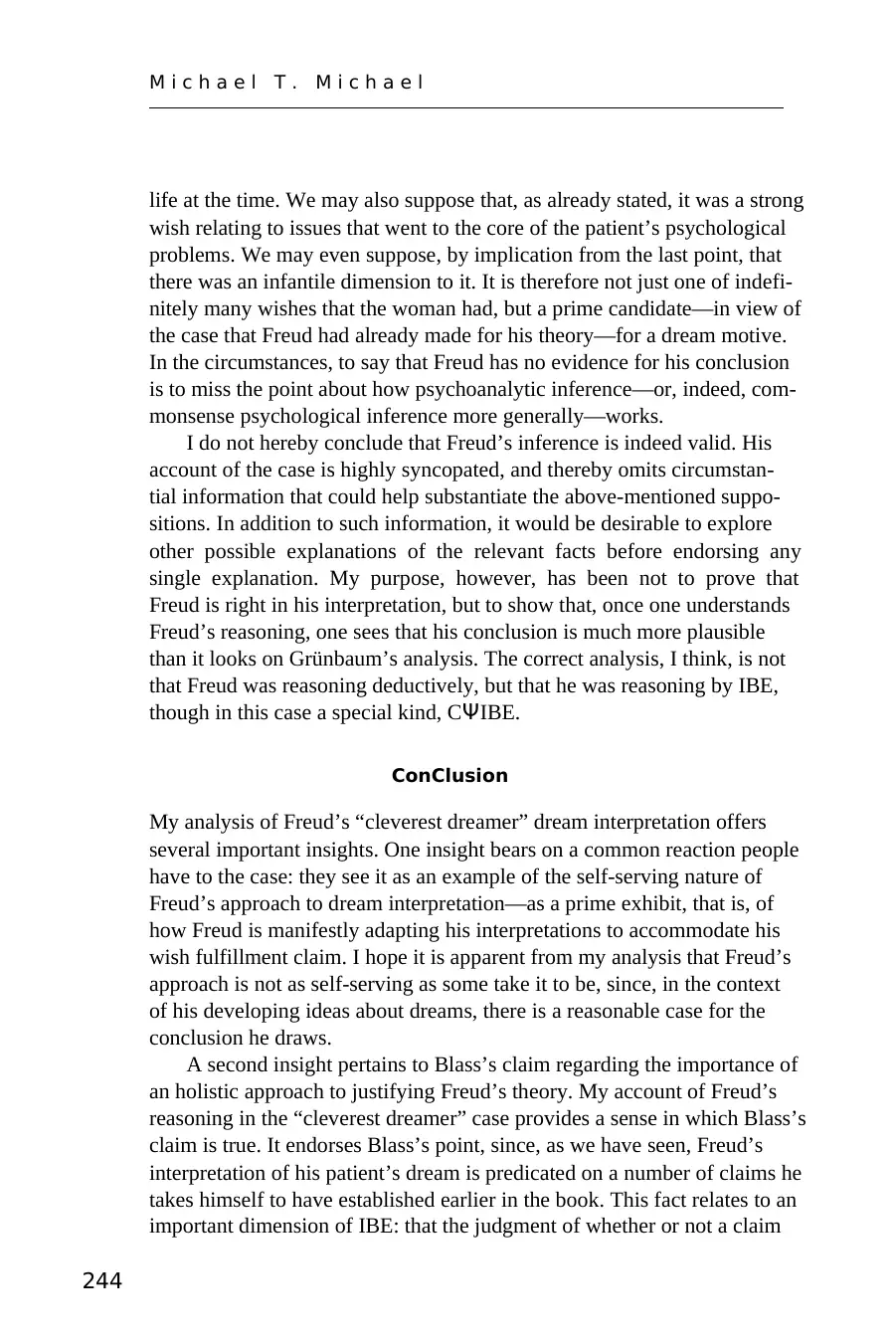
M i c h a e l T . M i c h a e l
244
life at the time. We may also suppose that, as already stated, it was a strong
wish relating to issues that went to the core of the patient’s psychological
problems. We may even suppose, by implication from the last point, that
there was an infantile dimension to it. It is therefore not just one of indefi-
nitely many wishes that the woman had, but a prime candidate—in view of
the case that Freud had already made for his theory—for a dream motive.
In the circumstances, to say that Freud has no evidence for his conclusion
is to miss the point about how psychoanalytic inference—or, indeed, com-
monsense psychological inference more generally—works.
I do not hereby conclude that Freud’s inference is indeed valid. His
account of the case is highly syncopated, and thereby omits circumstan-
tial information that could help substantiate the above-mentioned suppo-
sitions. In addition to such information, it would be desirable to explore
other possible explanations of the relevant facts before endorsing any
single explanation. My purpose, however, has been not to prove that
Freud is right in his interpretation, but to show that, once one understands
Freud’s reasoning, one sees that his conclusion is much more plausible
than it looks on Grünbaum’s analysis. The correct analysis, I think, is not
that Freud was reasoning deductively, but that he was reasoning by IBE,
though in this case a special kind, CΨIBE.
ConClusion
My analysis of Freud’s “cleverest dreamer” dream interpretation offers
several important insights. One insight bears on a common reaction people
have to the case: they see it as an example of the self-serving nature of
Freud’s approach to dream interpretation—as a prime exhibit, that is, of
how Freud is manifestly adapting his interpretations to accommodate his
wish fulfillment claim. I hope it is apparent from my analysis that Freud’s
approach is not as self-serving as some take it to be, since, in the context
of his developing ideas about dreams, there is a reasonable case for the
conclusion he draws.
A second insight pertains to Blass’s claim regarding the importance of
an holistic approach to justifying Freud’s theory. My account of Freud’s
reasoning in the “cleverest dreamer” case provides a sense in which Blass’s
claim is true. It endorses Blass’s point, since, as we have seen, Freud’s
interpretation of his patient’s dream is predicated on a number of claims he
takes himself to have established earlier in the book. This fact relates to an
important dimension of IBE: that the judgment of whether or not a claim
244
life at the time. We may also suppose that, as already stated, it was a strong
wish relating to issues that went to the core of the patient’s psychological
problems. We may even suppose, by implication from the last point, that
there was an infantile dimension to it. It is therefore not just one of indefi-
nitely many wishes that the woman had, but a prime candidate—in view of
the case that Freud had already made for his theory—for a dream motive.
In the circumstances, to say that Freud has no evidence for his conclusion
is to miss the point about how psychoanalytic inference—or, indeed, com-
monsense psychological inference more generally—works.
I do not hereby conclude that Freud’s inference is indeed valid. His
account of the case is highly syncopated, and thereby omits circumstan-
tial information that could help substantiate the above-mentioned suppo-
sitions. In addition to such information, it would be desirable to explore
other possible explanations of the relevant facts before endorsing any
single explanation. My purpose, however, has been not to prove that
Freud is right in his interpretation, but to show that, once one understands
Freud’s reasoning, one sees that his conclusion is much more plausible
than it looks on Grünbaum’s analysis. The correct analysis, I think, is not
that Freud was reasoning deductively, but that he was reasoning by IBE,
though in this case a special kind, CΨIBE.
ConClusion
My analysis of Freud’s “cleverest dreamer” dream interpretation offers
several important insights. One insight bears on a common reaction people
have to the case: they see it as an example of the self-serving nature of
Freud’s approach to dream interpretation—as a prime exhibit, that is, of
how Freud is manifestly adapting his interpretations to accommodate his
wish fulfillment claim. I hope it is apparent from my analysis that Freud’s
approach is not as self-serving as some take it to be, since, in the context
of his developing ideas about dreams, there is a reasonable case for the
conclusion he draws.
A second insight pertains to Blass’s claim regarding the importance of
an holistic approach to justifying Freud’s theory. My account of Freud’s
reasoning in the “cleverest dreamer” case provides a sense in which Blass’s
claim is true. It endorses Blass’s point, since, as we have seen, Freud’s
interpretation of his patient’s dream is predicated on a number of claims he
takes himself to have established earlier in the book. This fact relates to an
important dimension of IBE: that the judgment of whether or not a claim
Secure Best Marks with AI Grader
Need help grading? Try our AI Grader for instant feedback on your assignments.
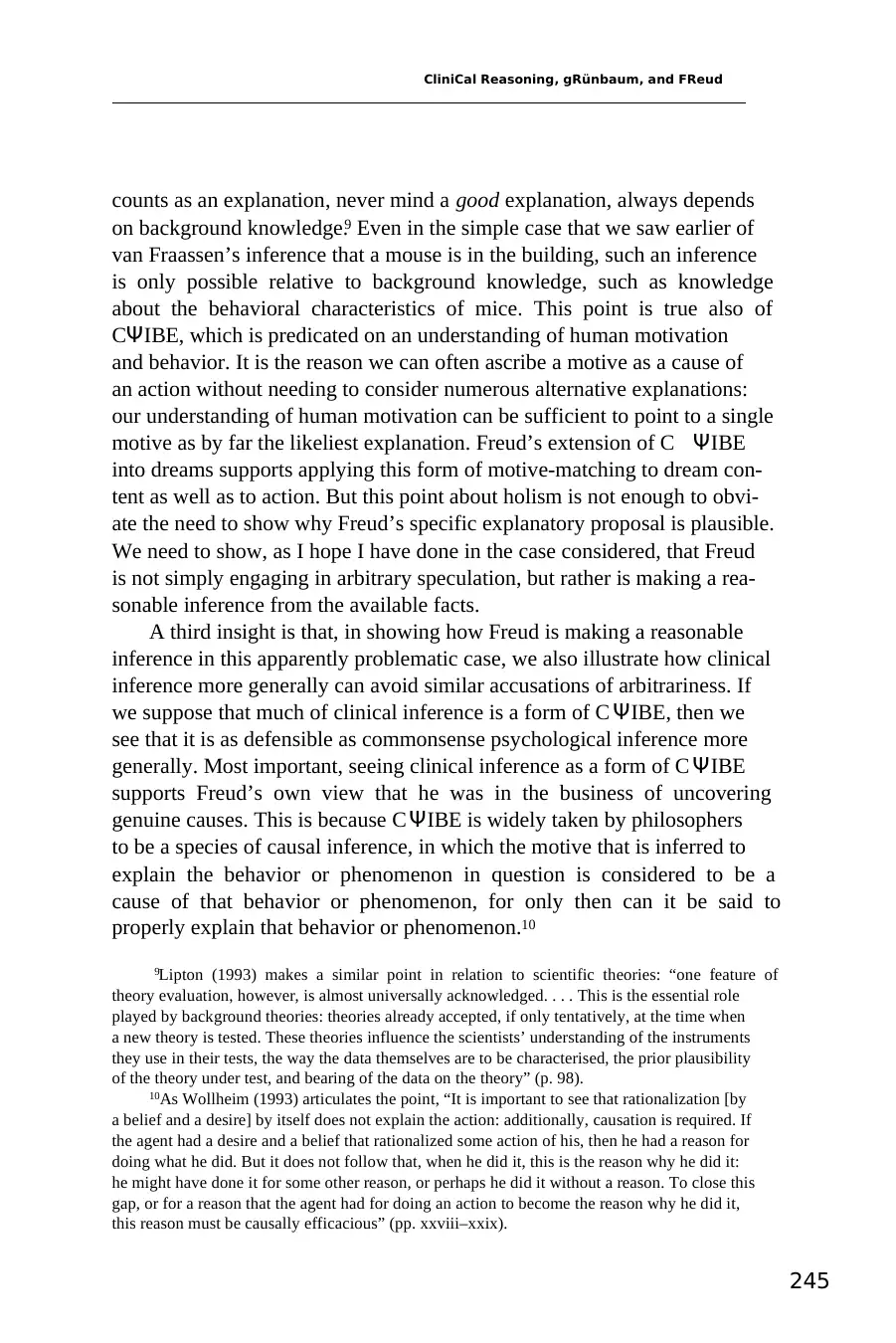
CliniCal Reasoning, gRünbaum, and FReud
245
counts as an explanation, never mind a good explanation, always depends
on background knowledge.9 Even in the simple case that we saw earlier of
van Fraassen’s inference that a mouse is in the building, such an inference
is only possible relative to background knowledge, such as knowledge
about the behavioral characteristics of mice. This point is true also of
CΨIBE, which is predicated on an understanding of human motivation
and behavior. It is the reason we can often ascribe a motive as a cause of
an action without needing to consider numerous alternative explanations:
our understanding of human motivation can be sufficient to point to a single
motive as by far the likeliest explanation. Freud’s extension of C ΨIBE
into dreams supports applying this form of motive-matching to dream con-
tent as well as to action. But this point about holism is not enough to obvi-
ate the need to show why Freud’s specific explanatory proposal is plausible.
We need to show, as I hope I have done in the case considered, that Freud
is not simply engaging in arbitrary speculation, but rather is making a rea-
sonable inference from the available facts.
A third insight is that, in showing how Freud is making a reasonable
inference in this apparently problematic case, we also illustrate how clinical
inference more generally can avoid similar accusations of arbitrariness. If
we suppose that much of clinical inference is a form of C ΨIBE, then we
see that it is as defensible as commonsense psychological inference more
generally. Most important, seeing clinical inference as a form of C ΨIBE
supports Freud’s own view that he was in the business of uncovering
genuine causes. This is because C ΨIBE is widely taken by philosophers
to be a species of causal inference, in which the motive that is inferred to
explain the behavior or phenomenon in question is considered to be a
cause of that behavior or phenomenon, for only then can it be said to
properly explain that behavior or phenomenon.10
9Lipton (1993) makes a similar point in relation to scientific theories: “one feature of
theory evaluation, however, is almost universally acknowledged. . . . This is the essential role
played by background theories: theories already accepted, if only tentatively, at the time when
a new theory is tested. These theories influence the scientists’ understanding of the instruments
they use in their tests, the way the data themselves are to be characterised, the prior plausibility
of the theory under test, and bearing of the data on the theory” (p. 98).
10As Wollheim (1993) articulates the point, “It is important to see that rationalization [by
a belief and a desire] by itself does not explain the action: additionally, causation is required. If
the agent had a desire and a belief that rationalized some action of his, then he had a reason for
doing what he did. But it does not follow that, when he did it, this is the reason why he did it:
he might have done it for some other reason, or perhaps he did it without a reason. To close this
gap, or for a reason that the agent had for doing an action to become the reason why he did it,
this reason must be causally efficacious” (pp. xxviii–xxix).
245
counts as an explanation, never mind a good explanation, always depends
on background knowledge.9 Even in the simple case that we saw earlier of
van Fraassen’s inference that a mouse is in the building, such an inference
is only possible relative to background knowledge, such as knowledge
about the behavioral characteristics of mice. This point is true also of
CΨIBE, which is predicated on an understanding of human motivation
and behavior. It is the reason we can often ascribe a motive as a cause of
an action without needing to consider numerous alternative explanations:
our understanding of human motivation can be sufficient to point to a single
motive as by far the likeliest explanation. Freud’s extension of C ΨIBE
into dreams supports applying this form of motive-matching to dream con-
tent as well as to action. But this point about holism is not enough to obvi-
ate the need to show why Freud’s specific explanatory proposal is plausible.
We need to show, as I hope I have done in the case considered, that Freud
is not simply engaging in arbitrary speculation, but rather is making a rea-
sonable inference from the available facts.
A third insight is that, in showing how Freud is making a reasonable
inference in this apparently problematic case, we also illustrate how clinical
inference more generally can avoid similar accusations of arbitrariness. If
we suppose that much of clinical inference is a form of C ΨIBE, then we
see that it is as defensible as commonsense psychological inference more
generally. Most important, seeing clinical inference as a form of C ΨIBE
supports Freud’s own view that he was in the business of uncovering
genuine causes. This is because C ΨIBE is widely taken by philosophers
to be a species of causal inference, in which the motive that is inferred to
explain the behavior or phenomenon in question is considered to be a
cause of that behavior or phenomenon, for only then can it be said to
properly explain that behavior or phenomenon.10
9Lipton (1993) makes a similar point in relation to scientific theories: “one feature of
theory evaluation, however, is almost universally acknowledged. . . . This is the essential role
played by background theories: theories already accepted, if only tentatively, at the time when
a new theory is tested. These theories influence the scientists’ understanding of the instruments
they use in their tests, the way the data themselves are to be characterised, the prior plausibility
of the theory under test, and bearing of the data on the theory” (p. 98).
10As Wollheim (1993) articulates the point, “It is important to see that rationalization [by
a belief and a desire] by itself does not explain the action: additionally, causation is required. If
the agent had a desire and a belief that rationalized some action of his, then he had a reason for
doing what he did. But it does not follow that, when he did it, this is the reason why he did it:
he might have done it for some other reason, or perhaps he did it without a reason. To close this
gap, or for a reason that the agent had for doing an action to become the reason why he did it,
this reason must be causally efficacious” (pp. xxviii–xxix).
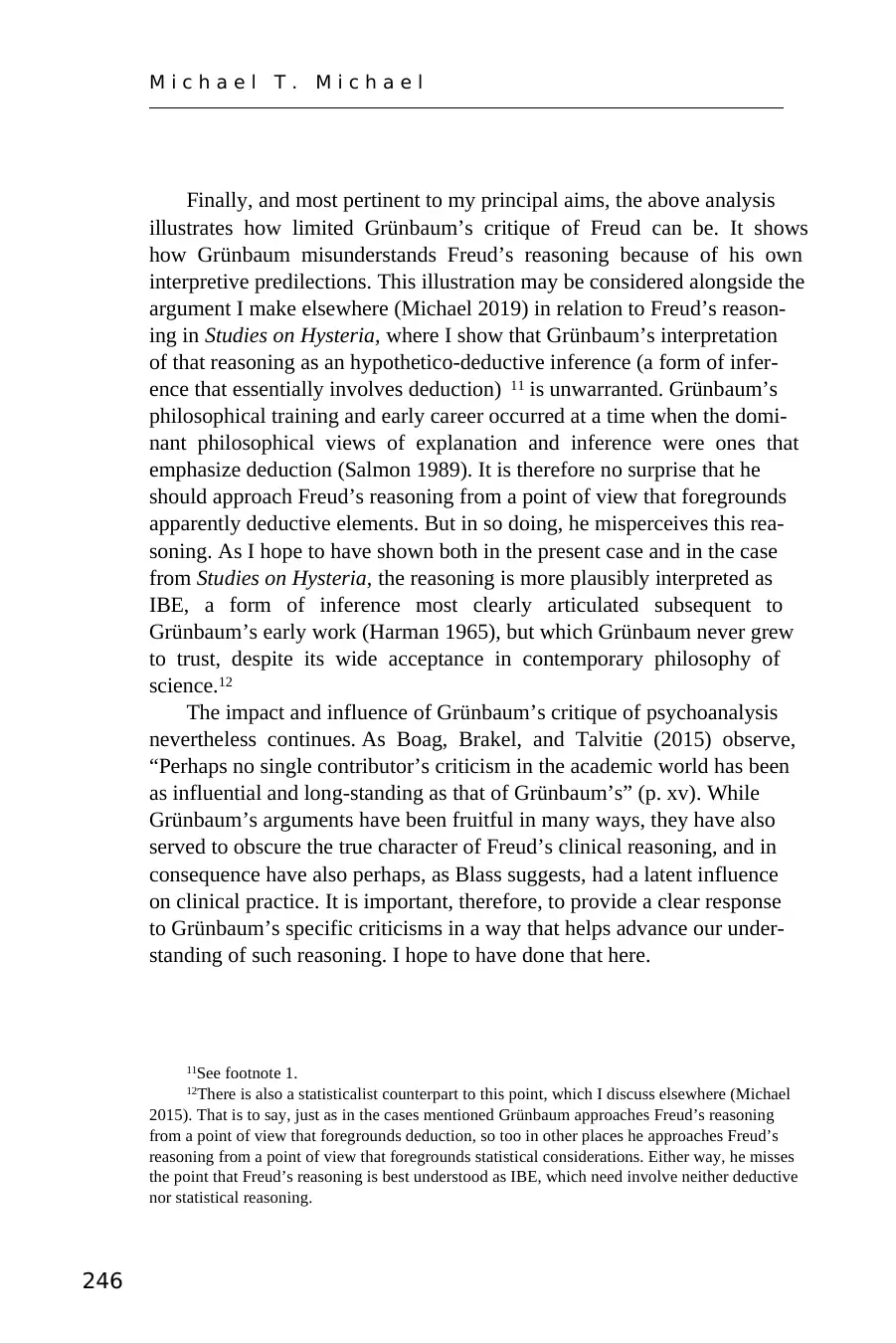
M i c h a e l T . M i c h a e l
246
Finally, and most pertinent to my principal aims, the above analysis
illustrates how limited Grünbaum’s critique of Freud can be. It shows
how Grünbaum misunderstands Freud’s reasoning because of his own
interpretive predilections. This illustration may be considered alongside the
argument I make elsewhere (Michael 2019) in relation to Freud’s reason-
ing in Studies on Hysteria, where I show that Grünbaum’s interpretation
of that reasoning as an hypothetico-deductive inference (a form of infer-
ence that essentially involves deduction) 11 is unwarranted. Grünbaum’s
philosophical training and early career occurred at a time when the domi-
nant philosophical views of explanation and inference were ones that
emphasize deduction (Salmon 1989). It is therefore no surprise that he
should approach Freud’s reasoning from a point of view that foregrounds
apparently deductive elements. But in so doing, he misperceives this rea-
soning. As I hope to have shown both in the present case and in the case
from Studies on Hysteria, the reasoning is more plausibly interpreted as
IBE, a form of inference most clearly articulated subsequent to
Grünbaum’s early work (Harman 1965), but which Grünbaum never grew
to trust, despite its wide acceptance in contemporary philosophy of
science.12
The impact and influence of Grünbaum’s critique of psychoanalysis
nevertheless continues. As Boag, Brakel, and Talvitie (2015) observe,
“Perhaps no single contributor’s criticism in the academic world has been
as influential and long-standing as that of Grünbaum’s” (p. xv). While
Grünbaum’s arguments have been fruitful in many ways, they have also
served to obscure the true character of Freud’s clinical reasoning, and in
consequence have also perhaps, as Blass suggests, had a latent influence
on clinical practice. It is important, therefore, to provide a clear response
to Grünbaum’s specific criticisms in a way that helps advance our under-
standing of such reasoning. I hope to have done that here.
11See footnote 1.
12There is also a statisticalist counterpart to this point, which I discuss elsewhere (Michael
2015). That is to say, just as in the cases mentioned Grünbaum approaches Freud’s reasoning
from a point of view that foregrounds deduction, so too in other places he approaches Freud’s
reasoning from a point of view that foregrounds statistical considerations. Either way, he misses
the point that Freud’s reasoning is best understood as IBE, which need involve neither deductive
nor statistical reasoning.
246
Finally, and most pertinent to my principal aims, the above analysis
illustrates how limited Grünbaum’s critique of Freud can be. It shows
how Grünbaum misunderstands Freud’s reasoning because of his own
interpretive predilections. This illustration may be considered alongside the
argument I make elsewhere (Michael 2019) in relation to Freud’s reason-
ing in Studies on Hysteria, where I show that Grünbaum’s interpretation
of that reasoning as an hypothetico-deductive inference (a form of infer-
ence that essentially involves deduction) 11 is unwarranted. Grünbaum’s
philosophical training and early career occurred at a time when the domi-
nant philosophical views of explanation and inference were ones that
emphasize deduction (Salmon 1989). It is therefore no surprise that he
should approach Freud’s reasoning from a point of view that foregrounds
apparently deductive elements. But in so doing, he misperceives this rea-
soning. As I hope to have shown both in the present case and in the case
from Studies on Hysteria, the reasoning is more plausibly interpreted as
IBE, a form of inference most clearly articulated subsequent to
Grünbaum’s early work (Harman 1965), but which Grünbaum never grew
to trust, despite its wide acceptance in contemporary philosophy of
science.12
The impact and influence of Grünbaum’s critique of psychoanalysis
nevertheless continues. As Boag, Brakel, and Talvitie (2015) observe,
“Perhaps no single contributor’s criticism in the academic world has been
as influential and long-standing as that of Grünbaum’s” (p. xv). While
Grünbaum’s arguments have been fruitful in many ways, they have also
served to obscure the true character of Freud’s clinical reasoning, and in
consequence have also perhaps, as Blass suggests, had a latent influence
on clinical practice. It is important, therefore, to provide a clear response
to Grünbaum’s specific criticisms in a way that helps advance our under-
standing of such reasoning. I hope to have done that here.
11See footnote 1.
12There is also a statisticalist counterpart to this point, which I discuss elsewhere (Michael
2015). That is to say, just as in the cases mentioned Grünbaum approaches Freud’s reasoning
from a point of view that foregrounds deduction, so too in other places he approaches Freud’s
reasoning from a point of view that foregrounds statistical considerations. Either way, he misses
the point that Freud’s reasoning is best understood as IBE, which need involve neither deductive
nor statistical reasoning.
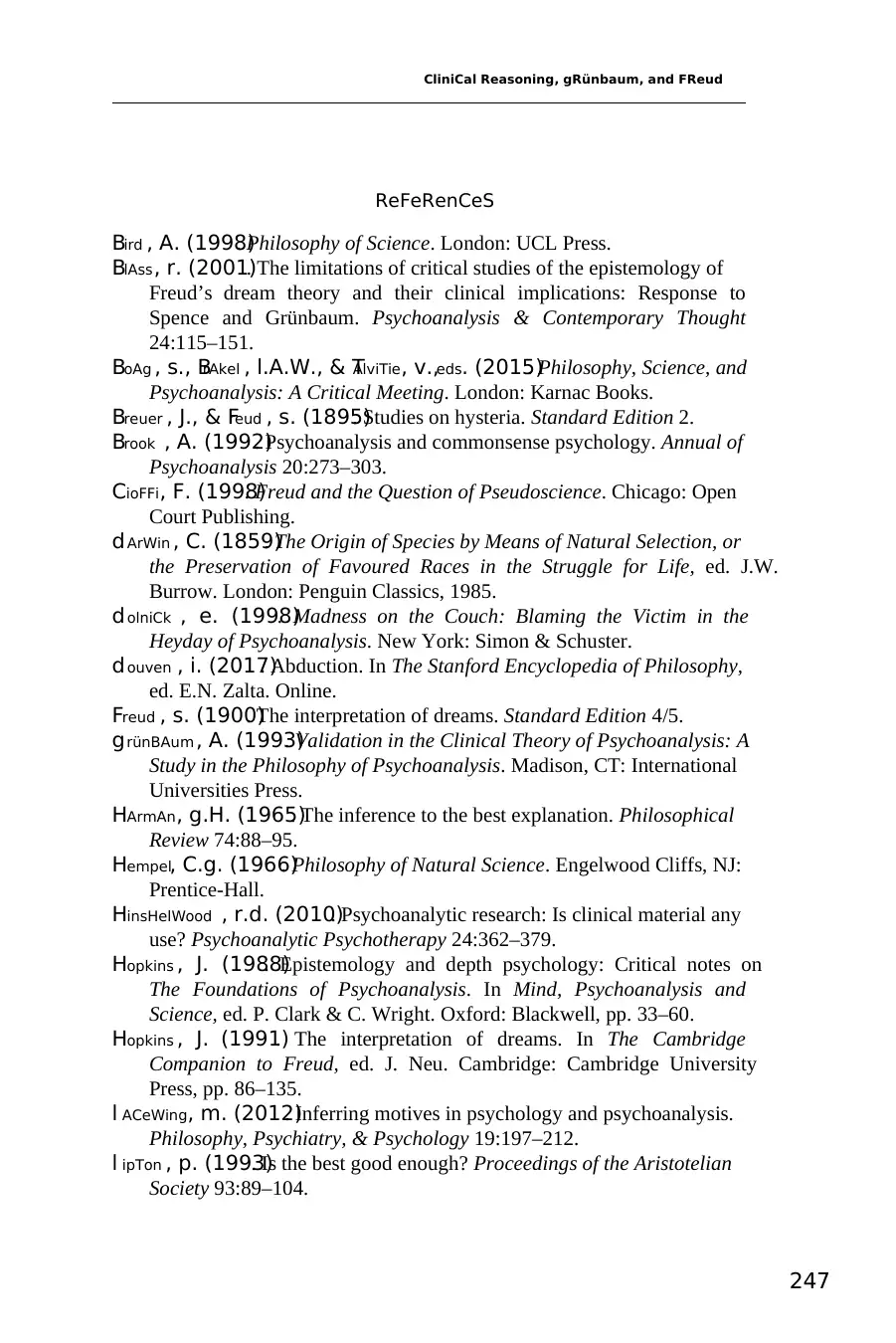
CliniCal Reasoning, gRünbaum, and FReud
247
ReFeRenCeS
Bird , A. (1998). Philosophy of Science. London: UCL Press.
BlAss, r. (2001). The limitations of critical studies of the epistemology of
Freud’s dream theory and their clinical implications: Response to
Spence and Grünbaum. Psychoanalysis & Contemporary Thought
24:115–151.
BoAg , s., BrAkel , l.A.W., & TAlviTie, v.,eds. (2015). Philosophy, Science, and
Psychoanalysis: A Critical Meeting. London: Karnac Books.
Breuer , J., & Freud , s. (1895). Studies on hysteria. Standard Edition 2.
Brook , A. (1992). Psychoanalysis and commonsense psychology. Annual of
Psychoanalysis 20:273–303.
CioFFi, F. (1998). Freud and the Question of Pseudoscience. Chicago: Open
Court Publishing.
d ArWin , C. (1859). The Origin of Species by Means of Natural Selection, or
the Preservation of Favoured Races in the Struggle for Life, ed. J.W.
Burrow. London: Penguin Classics, 1985.
d olniCk , e. (1998). Madness on the Couch: Blaming the Victim in the
Heyday of Psychoanalysis. New York: Simon & Schuster.
d ouven , i. (2017). Abduction. In The Stanford Encyclopedia of Philosophy,
ed. E.N. Zalta. Online.
Freud , s. (1900). The interpretation of dreams. Standard Edition 4/5.
grünBAum , A. (1993). Validation in the Clinical Theory of Psychoanalysis: A
Study in the Philosophy of Psychoanalysis. Madison, CT: International
Universities Press.
HArmAn, g.H. (1965). The inference to the best explanation. Philosophical
Review 74:88–95.
Hempel, C.g. (1966). Philosophy of Natural Science. Engelwood Cliffs, NJ:
Prentice-Hall.
HinsHelWood , r.d. (2010). Psychoanalytic research: Is clinical material any
use? Psychoanalytic Psychotherapy 24:362–379.
Hopkins , J. (1988). Epistemology and depth psychology: Critical notes on
The Foundations of Psychoanalysis. In Mind, Psychoanalysis and
Science, ed. P. Clark & C. Wright. Oxford: Blackwell, pp. 33–60.
Hopkins , J. (1991). The interpretation of dreams. In The Cambridge
Companion to Freud, ed. J. Neu. Cambridge: Cambridge University
Press, pp. 86–135.
l ACeWing, m. (2012). Inferring motives in psychology and psychoanalysis.
Philosophy, Psychiatry, & Psychology 19:197–212.
l ipTon , p. (1993). Is the best good enough? Proceedings of the Aristotelian
Society 93:89–104.
247
ReFeRenCeS
Bird , A. (1998). Philosophy of Science. London: UCL Press.
BlAss, r. (2001). The limitations of critical studies of the epistemology of
Freud’s dream theory and their clinical implications: Response to
Spence and Grünbaum. Psychoanalysis & Contemporary Thought
24:115–151.
BoAg , s., BrAkel , l.A.W., & TAlviTie, v.,eds. (2015). Philosophy, Science, and
Psychoanalysis: A Critical Meeting. London: Karnac Books.
Breuer , J., & Freud , s. (1895). Studies on hysteria. Standard Edition 2.
Brook , A. (1992). Psychoanalysis and commonsense psychology. Annual of
Psychoanalysis 20:273–303.
CioFFi, F. (1998). Freud and the Question of Pseudoscience. Chicago: Open
Court Publishing.
d ArWin , C. (1859). The Origin of Species by Means of Natural Selection, or
the Preservation of Favoured Races in the Struggle for Life, ed. J.W.
Burrow. London: Penguin Classics, 1985.
d olniCk , e. (1998). Madness on the Couch: Blaming the Victim in the
Heyday of Psychoanalysis. New York: Simon & Schuster.
d ouven , i. (2017). Abduction. In The Stanford Encyclopedia of Philosophy,
ed. E.N. Zalta. Online.
Freud , s. (1900). The interpretation of dreams. Standard Edition 4/5.
grünBAum , A. (1993). Validation in the Clinical Theory of Psychoanalysis: A
Study in the Philosophy of Psychoanalysis. Madison, CT: International
Universities Press.
HArmAn, g.H. (1965). The inference to the best explanation. Philosophical
Review 74:88–95.
Hempel, C.g. (1966). Philosophy of Natural Science. Engelwood Cliffs, NJ:
Prentice-Hall.
HinsHelWood , r.d. (2010). Psychoanalytic research: Is clinical material any
use? Psychoanalytic Psychotherapy 24:362–379.
Hopkins , J. (1988). Epistemology and depth psychology: Critical notes on
The Foundations of Psychoanalysis. In Mind, Psychoanalysis and
Science, ed. P. Clark & C. Wright. Oxford: Blackwell, pp. 33–60.
Hopkins , J. (1991). The interpretation of dreams. In The Cambridge
Companion to Freud, ed. J. Neu. Cambridge: Cambridge University
Press, pp. 86–135.
l ACeWing, m. (2012). Inferring motives in psychology and psychoanalysis.
Philosophy, Psychiatry, & Psychology 19:197–212.
l ipTon , p. (1993). Is the best good enough? Proceedings of the Aristotelian
Society 93:89–104.
Paraphrase This Document
Need a fresh take? Get an instant paraphrase of this document with our AI Paraphraser
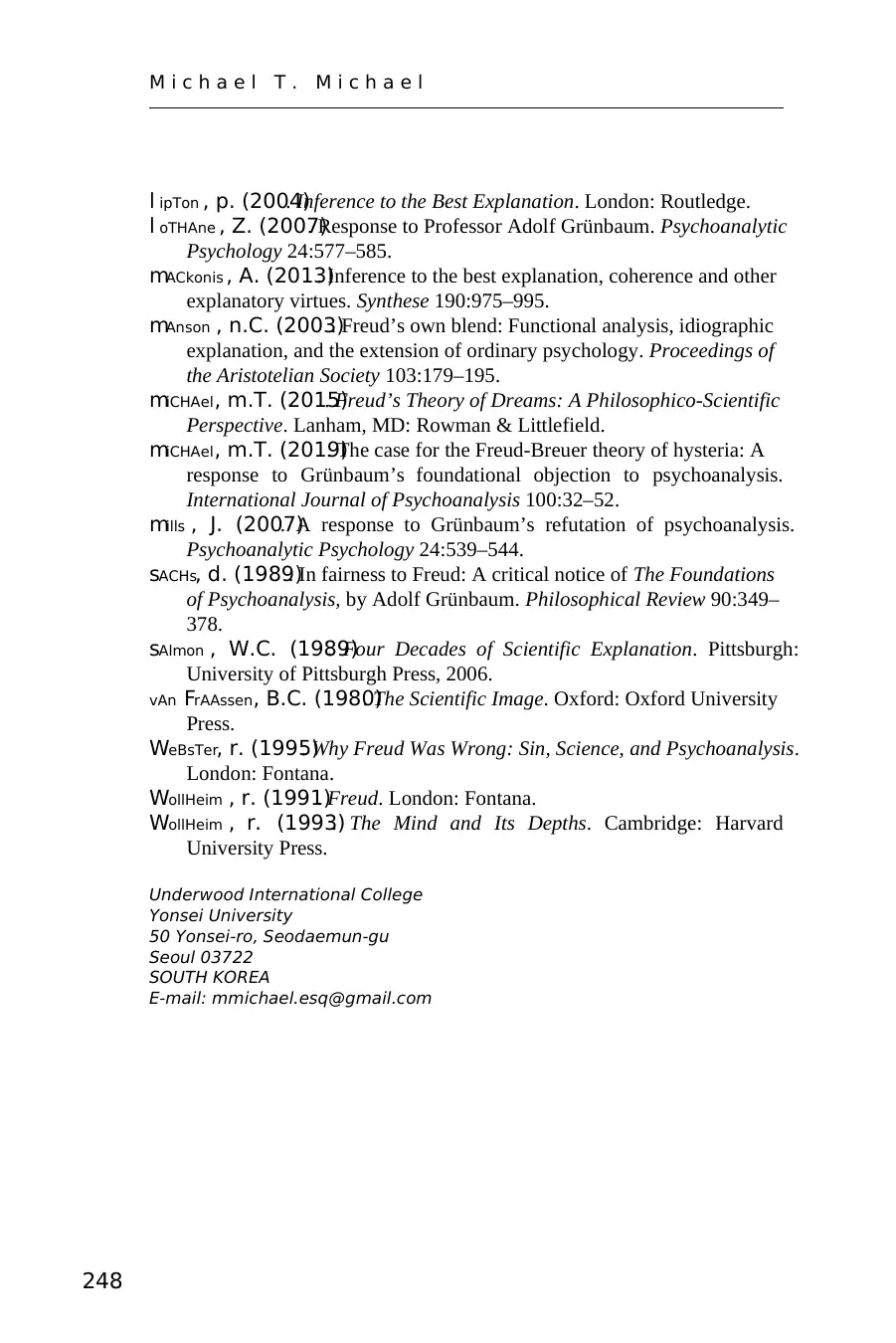
M i c h a e l T . M i c h a e l
248
l ipTon , p. (2004). Inference to the Best Explanation. London: Routledge.
l oTHAne , Z. (2007). Response to Professor Adolf Grünbaum. Psychoanalytic
Psychology 24:577–585.
mACkonis , A. (2013). Inference to the best explanation, coherence and other
explanatory virtues. Synthese 190:975–995.
mAnson , n.C. (2003). Freud’s own blend: Functional analysis, idiographic
explanation, and the extension of ordinary psychology. Proceedings of
the Aristotelian Society 103:179–195.
miCHAel, m.T. (2015). Freud’s Theory of Dreams: A Philosophico-Scientific
Perspective. Lanham, MD: Rowman & Littlefield.
miCHAel, m.T. (2019). The case for the Freud-Breuer theory of hysteria: A
response to Grünbaum’s foundational objection to psychoanalysis.
International Journal of Psychoanalysis 100:32–52.
mills , J. (2007). A response to Grünbaum’s refutation of psychoanalysis.
Psychoanalytic Psychology 24:539–544.
sACHs, d. (1989). In fairness to Freud: A critical notice of The Foundations
of Psychoanalysis, by Adolf Grünbaum. Philosophical Review 90:349–
378.
sAlmon , W.C. (1989). Four Decades of Scientific Explanation. Pittsburgh:
University of Pittsburgh Press, 2006.
vAn FrAAssen, B.C. (1980). The Scientific Image. Oxford: Oxford University
Press.
WeBsTer, r. (1995). Why Freud Was Wrong: Sin, Science, and Psychoanalysis.
London: Fontana.
WollHeim , r. (1991). Freud. London: Fontana.
WollHeim , r. (1993). The Mind and Its Depths. Cambridge: Harvard
University Press.
Underwood International College
Yonsei University
50 Yonsei-ro, Seodaemun-gu
Seoul 03722
SOUTH KOREA
E-mail: mmichael.esq@gmail.com
248
l ipTon , p. (2004). Inference to the Best Explanation. London: Routledge.
l oTHAne , Z. (2007). Response to Professor Adolf Grünbaum. Psychoanalytic
Psychology 24:577–585.
mACkonis , A. (2013). Inference to the best explanation, coherence and other
explanatory virtues. Synthese 190:975–995.
mAnson , n.C. (2003). Freud’s own blend: Functional analysis, idiographic
explanation, and the extension of ordinary psychology. Proceedings of
the Aristotelian Society 103:179–195.
miCHAel, m.T. (2015). Freud’s Theory of Dreams: A Philosophico-Scientific
Perspective. Lanham, MD: Rowman & Littlefield.
miCHAel, m.T. (2019). The case for the Freud-Breuer theory of hysteria: A
response to Grünbaum’s foundational objection to psychoanalysis.
International Journal of Psychoanalysis 100:32–52.
mills , J. (2007). A response to Grünbaum’s refutation of psychoanalysis.
Psychoanalytic Psychology 24:539–544.
sACHs, d. (1989). In fairness to Freud: A critical notice of The Foundations
of Psychoanalysis, by Adolf Grünbaum. Philosophical Review 90:349–
378.
sAlmon , W.C. (1989). Four Decades of Scientific Explanation. Pittsburgh:
University of Pittsburgh Press, 2006.
vAn FrAAssen, B.C. (1980). The Scientific Image. Oxford: Oxford University
Press.
WeBsTer, r. (1995). Why Freud Was Wrong: Sin, Science, and Psychoanalysis.
London: Fontana.
WollHeim , r. (1991). Freud. London: Fontana.
WollHeim , r. (1993). The Mind and Its Depths. Cambridge: Harvard
University Press.
Underwood International College
Yonsei University
50 Yonsei-ro, Seodaemun-gu
Seoul 03722
SOUTH KOREA
E-mail: mmichael.esq@gmail.com
1 out of 20
Your All-in-One AI-Powered Toolkit for Academic Success.
+13062052269
info@desklib.com
Available 24*7 on WhatsApp / Email
![[object Object]](/_next/static/media/star-bottom.7253800d.svg)
Unlock your academic potential
© 2024 | Zucol Services PVT LTD | All rights reserved.